|
When I was growing up, I was perpetually fascinated by matters relegated to realms unknown. Namely, this applied to such phenomena as witchcraft, psychic dreams, ESP, curses, and other related and unexplainable activity. In part, I believe that this fascination stemmed from the stories my father would make up to lull my younger siblings and me to sleep at night, as well as the folktales – some of them quite frightening – that I used to enjoy reading when I was relatively young. But mainly, I was piqued from early-on by the unusual occurrences my maternal grandmother, Tola Pszenica Pinkus (b. Warsaw, 1921-d. Chicago, 1999), related to me about her family and herself, growing up in pre-World War II Warsaw, Poland. I always found these unusual occurrences all the more intriguing, given that my grandmother hailed from an upwardly mobile and well-educated Chasidic family that was fairly modern and well-integrated in Polish – and particularly, in Warsaw Jewish – society. Indeed, my grandmother attended Polish public schools and was on the verge of entering her final year of Gymnasium [a college preparatory high school] when World War II broke out on September 1, 1939. What’s more, her father was a polyglot who knew seven languages, a businessman, and medically-trained man who was revered for his knowledge, both by local Jewish and Gentile Polish society. Supernatural occurrences and beliefs are often associated with small-town shtetl life or those who are deemed highly emotional, impressionable, backward, and possibly also rather ignorant and/or poorly educated. These stereotypes simply did not hold sway with my grandmother or members of her family. 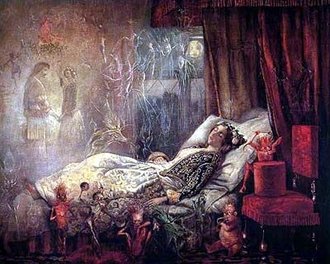 Illustration of a woman immersed in a vivid dream. (Courtesy of Beyond the Borderline Personality, accessed 5-5-17.) Illustration of a woman immersed in a vivid dream. (Courtesy of Beyond the Borderline Personality, accessed 5-5-17.) The accounts that I heard most frequently within the realm of “the unknown” pertained to what may be deemed the “psychic dreams” of my grandmother and some of her close Pszenica family members. Given that my grandmother had what I considered the “gift of second sight” – something that appeared to run in her paternal family – I often wondered, as a child, whether I too would ever show signs of this “gift.” On at least one occasion when I mentioned this to my grandmother, she became somewhat irritated with me and responded in her typical matter-of-fact Warsaw Yiddish and slightly-accented English: “Believe me, Rivka, you do not want or need such a gift! S’iz behopt nisht ka’ matune! (It’s no gift at all!)!” When I would then declare my grandmother a “witch” (makhasheyfe in Yiddish) – since witches are said to possess powers of the unknown – my grandmother would usually scoff at me with some of her most typical Yiddish expressions: “Hak mir nisht in shvakhn kop (aran)!” (Literally: “Don’t bang my weak head!”; figuratively: “Stop pestering me!”), “Hak mir nisht ka’ tshaynik!” (Literally: “Don’t bang the tea kettle at me!”; figuratively: “Don’t bother me!”), and “Vus redsti aza narishkaytn?!” (“What are you talking such nonsense?!”). As indicated by my grandmother’s aforementioned reactions, one might say that she viewed this “gift” as perhaps more of a curse than anything else, and that she did not consider this something worthy of my taking it as seriously as I did. Apparently, my grandmother herself had several such unusual dreams throughout her lifetime, beginning from when she was a relatively young girl of perhaps 10, and lasting up until the 1950s – at least – in her post-World War II life in Chicago. The earliest such account that I heard numerous times (because I asked my grandmother to retell it on multiple occasions) was that of the dream that my grandmother had when she was a child and had contracted scarlet fever. As my grandmother conveyed to me, scarlet fever was a potentially fatal disease that children of that place and era (Warsaw, early 1930s) often did not survive; and those who did, were often left brain-damaged, deaf, with heart-damage, and/or a host of other lifelong maladies. During the course of a single night, my grandmother’s temperature rose to a dangerously high level, such that the consulted doctors did not believe that she would survive this ordeal – and that if she did, she would essentially be left a “human vegetable.” As she lay in bed in a comatose-like state, my grandmother had a dream in which she witnessed her namesake, Tobe Sure Pszenica, the mother of her paternal grandfather, Rachmiel Yosef Pszenica. The first Tobe Sure (my grandmother being the second) had died relatively young, even before my grandmother’s father, Toivye Gitman, was born. Therefore, the only immediate physical witness at the time to this foremother was that of my grandmother’s grandfather. After all, there were no photos dating back that far, and I am uncertain how many photos the family had in general, given that photos were not terribly cheap, nor were they as widely accepted among Chasidic Jews (like my grandmother’s family). Indeed, when I asked my grandmother about family photos, her pragmatic and to-the-point remark was: “Ver hot dentsmul gehat gelt ts’ makhn bilder?!” (“Who had the money in those days to make photos?!”) In the dream, my grandmother’s namesake comforted her by presenting her with some beautiful well-ripened plums, saying: “Eat these nourishing plums, my dear, and you will soon be well again. Do not be afraid” – similarly, in Warsaw Yiddish: “Es di flomen, man tayerinke, un di vest bald zan gezint. Hob nisht ka’ moyre.” My grandmother heeded her great grandmother’s words and ravenously bit into the succulent fruit. All the while, as this dream was transpiring, my great grandfather, Toivye Gitman Pszenica and a quorum of adult males stood vigilante at my grandmother’s bedside reciting Psalms throughout the night. Finally, at some point, my grandmother’s fever broke, and she awoke shouting that she had seen “Bubbe [Grandmother] Tobe Sure,” her namesake. My great grandfather was very much moved by my grandmother’s account – especially since he himself had never known this first Tobe Sure. He, in turn, related the details surrounding my grandmother’s dream to his own father, Rachmiel Yosef, the son of the first Tobe Sure. When Rachmiel Yosef heard the physical description of the woman who appeared in my grandmother’s dream – especially, of the sheytl [wig] and brown jumper that she wore – he recognized all of this to be the mother whom he had known, and who had died many years before. He jumped up, exclaiming: “I know precisely which jumper you are talking about. This was an article of clothing my mother used to wear quite frequently.” Afterward, he went to search among old boxes of his departed mother’s belongings and found the exact brown jumper that he had had in mind. He brought it to my grandmother, who in turn confirmed that yes – this was, in fact, the very article of clothing that she had witnessed in her dream.  Jewish undertakers converse next to a pile of wooden coffins in the Warsaw ghetto. Over time, as mortality rates in the ghetto increased, burials in the Warsaw Jewish Cemetery were generally performed in mass graves. (Courtesy of the United States Holocaust Memorial Museum, accessed 5-6-27.) Jewish undertakers converse next to a pile of wooden coffins in the Warsaw ghetto. Over time, as mortality rates in the ghetto increased, burials in the Warsaw Jewish Cemetery were generally performed in mass graves. (Courtesy of the United States Holocaust Memorial Museum, accessed 5-6-27.) I believe that until her dying day, my grandmother credited her own great grandmother and namesake for looking over her and ultimately, for saving her young life through the power of that very real dream. A few years after that dream episode, also in the 1930s, my grandmother’s father showed her the headstone of the first “Tobe Sure Pszenica,” whose grave stood in the Warsaw Jewish Cemetery. As a postscript to this story, I have personally made several efforts to locate that grave on my multiple trips to the still-intact Jewish cemetery on Okopowa Street, but to-date, I have not been successful in locating it. Yet another story involving a “psychic dream” that my grandmother had before the Second World War, most likely a few years after the former dream, did not have such positive results. In this other dream, my grandmother unknowingly predicted the death of her maternal grandmother, Roize Urfajg Pinkiel. In the disturbing dream that my grandmother had one particular Friday night, she witnessed an undisclosed lifeless figure lying in bed surrounded by a large crowd of sobbing people. Among these individuals was her mother, Miriam Pinkiel Pszenica, hunched over the lifeless figure and sobbing uncontrollably. Not surprisingly, my grandmother woke up shaken, but I am not certain that she ever discussed the dream with any other family members. It was the regular custom in my grandmother’s family on the Sabbath [Shabes, in Yiddish] that her maternal grandmother would walk over to the Pszenica household following lunch, and the family would gather together, chat, take walks, and the like. But on this one Saturday afternoon following the night during which my grandmother had that frightful dream, Bubbe Roize did not show up at her usual time. Not long thereafter, there was a frantic knock at the apartment door, and a messenger appeared to inform Miriam Pszenica – my grandmother’s mother – that she had to come quickly, as her mother had suddenly become gravely ill and needed her daughter at her bedside. Bear in mind that up until that time, according to my grandmother, her maternal grandmother had never been seriously ill. Yes, she did adhere to cupping – also known as bankes in Yiddish – which was considered a remedy for circulatory problems, but otherwise, she was a rather fit woman. Thus, her illness took the entire family by complete surprise; it was not something that anyone could possibly have predicted beforehand. She had somehow developed an inflammation of the intestines, and in a matter of hours she was dead. Indeed, her daughter Miriam was at her bedside – just like my grandmother had dreamt the previous night – when she passed away. My grandmother’s menacing nighttime vision had in reality come to pass…  Warsaw Jewish Cemetery on ul. Okopowa, recently restored headstone atop the grave of my great great grandfather, Rachmiel Yosef Pszenica, who perished in the Warsaw ghetto in 1941 (b. 1866-d. 1941). (Photograph courtesy of Rivka Schiller, fall 2014.) Warsaw Jewish Cemetery on ul. Okopowa, recently restored headstone atop the grave of my great great grandfather, Rachmiel Yosef Pszenica, who perished in the Warsaw ghetto in 1941 (b. 1866-d. 1941). (Photograph courtesy of Rivka Schiller, fall 2014.) This was the only one of my grandmother’s four grandparents to die before the onslaught of the Warsaw ghetto. The other three were murdered in the early years of World War II/ the Holocaust. One of those other grandparents to die in the war was the aforementioned Rachmiel Yosef Pszenica, who passed away in July of 1941, and whose grave I visited in the Warsaw Jewish cemetery in 2014. In my grandmother’s opinion it was a great blessing for her departed grandmother to have died in the years leading up to the khurbn [Yiddish for a great catastrophe – the Holocaust]. In her words: “At least she was not murdered, but died of natural causes.” Sadly, I have to agree that my grandmother was correct. It was, in fact, a year after Bubbe Roize Pinkiel died that the family held a ceremony at the Warsaw Jewish cemetery to erect her headstone (or matseyve, in Yiddish). At that time, my grandmother’s father took her aside to show her the grave of her namesake, Tobe Sure Pszenica. This was the same woman whom I previously mentioned that saved my grandmother’s life through yet another “psychic dream.” Another remarkable dream my grandmother had, which also came to fruition, took place at the tail end of World War II, the night before she and her younger sister, Lola, were liberated by members of the Soviet Army in early May of 1945. By this point in time, my grandmother and great aunt had just been on a series of death marches ranging from Auschwitz to the Ravensbrück concentration camp, and other sub-camps. My grandmother was so ill and swollen from starvation and malnourishment that she was ready to give up and die. But during that last night of captivity she dreamt that her father, who had been dead already for a few years, having died of starvation in the Warsaw ghetto and been buried there in a mass grave, came to her and told her not to give up hope, for in the morning she would be rescued by three Jews. As it turned out, the following morning my grandmother was approached by a Russian soldier who informed her that he was a fellow Jew, that he had two accompanying Jewish fellows – also officers in the Soviet Army – and that they had come to liberate them. I do not know for certain what the common language was, but I would imagine that Yiddish may very well have factored into their verbal exchange. As my grandmother was to learn from this and subsequent dreams, whenever her departed father came to her in a dream, it was a sign of encouragement and strengthening, and that things would ultimately be alright. Conversely, when my grandmother was visited in a dream by her departed mother, it was a sign of warning that difficult times were ahead. Some years later, once my grandmother was already living with my grandfather, young mother, and my infant uncle in Chicago in the early 1950s, she had another one of these prescient dreams. This time around, though, she was visited by her mother, which as I just mentioned, was an omen of something ominous to come. In that “psychic dream” – the last of the ones about which I know anything – my great grandmother warned my grandmother that she would soon be met with a very trying and troubling year ahead. As I understand it, not long thereafter, my grandfather developed a rather pernicious form of TB. This was actually a recurrence of the tuberculosis he had developed during the war years, and for which he had endured multiple surgeries yet in postwar Germany. As a result of this highly contagious disease, my grandfather was placed in quarantine in the Chicago-Winfield Tuberculosis Sanatorium, located on the far-outskirts of the Chicagoland area. As my grandmother recalled, the sanatorium was only accessible to her by train, and the train only came once on the hour and only during certain hours. At the time, she had no vehicle, had two young children at home, had no source of income, and had few people to whom to turn for help. During that inauspicious year, the doctors at the sanatorium had little hope of my grandfather’s ever leaving in an upright position. What’s more, the bed that he was given still had the name tag of the previous patient attached to it. The unfortunate individual had also been a Holocaust survivor, and he had not pulled through. It goes without saying that none of this boded well. Furthermore, it all weighed heavily upon my grandmother. To make matters worse, my grandmother had brought my mother along on one of her visits, but because my grandfather was in quarantine, my grandmother and mother had to remain outside, waving to my grandfather at the window. This left my young mother in tears – not understanding why her father did not want to see her. From that point forth, my grandmother informed me that she could not bear to take my mother along with her anymore on those visits. It was simply too heartbreaking and painful for her. Ultimately, though, my grandfather proved the doctors wrong and recovered from the disease – but not before having to undergo more surgical procedures. Once he finally returned home from the sanatorium nearly a full year after having been admitted there, my uncle, who was two years old by that time, could not remember his father and ran away from him. As the story goes, my grandfather was able to lure in my uncle by showing him a pocket watch, which apparently fascinated my uncle and won him over. Although my grandfather miraculously survived that horrible year and returned home to his wife and two children, the dream that my grandmother had had with her departed mother had undeniably been fulfilled.  "Jacob’s Dream." Painting of the Biblical figure, Jacob, immersed in his famous dream of angels climbing up and down a ladder that reached into the heavens. (Courtesy of Pinterest, accessed 5-5-17.) "Jacob’s Dream." Painting of the Biblical figure, Jacob, immersed in his famous dream of angels climbing up and down a ladder that reached into the heavens. (Courtesy of Pinterest, accessed 5-5-17.) These are but some of the unusual accounts that were handed down to me via the oral tradition by my grandmother. I am the first one, as far as I know, to set down any of these stories in the written form. All of these particular accounts revolve around “psychic dreams” – dreams that carried with them a vision of something that was yet to come in the near future – whether for the better or for the worse. But there were still additional family accounts that my grandmother conveyed to me, which involved curses (“kloles,” in Yiddish), the “Evil Eye” (“Ayen-hore,” in Yiddish), name changing for the purpose of fooling the “Angel of Death” (“Malekhhamoves,” in Yiddish), and other such seemingly bizarre happenings. However, for the sake of brevity, I have had to limit the scope of this subject. I am sure that in my readers’ research into their own family histories, they have also come across unusual or unexplainable accounts such as the ones I have related here. These are undoubtedly the stories that help form a more nuanced mosaic of one’s genealogy, as they offer true insight into the human beings behind the names on the family tree, and the lives they led. Moreover, these are the types of accounts that have, at least in part, shaped generations of a family. I am curious to learn more about your own such accounts, and hope that you will please consider sharing snippets of these in my blog’s “Comments” section. If you have any Yiddish materials – perhaps even bearing family accounts of unusual or seemingly unexplained events – that you would like translated, please feel free to contact me at: rivka@rivkasyiddish.com.
28 Comments
In this month’s blog, I am doing things a little bit differently than I normally do. More specifically, I am sharing with you the guest blog of a good friend of mine, Annette Gendler, who just published her first book, Jumping Over Shadows: A Memoir, which I highly recommend you all read. Without giving away too much about the book’s plot, let’s just say that it revolves heavily around Annette’s genealogical journey and quest for answers about her family’s past in pre-World War II and wartime Czechoslovakia. The work also pertains to questions about identity – and more to the point – about Jewish identity. These are all topics that I have discussed in one form or another in my own past blog articles (see, for instance, my January 2017 blog), as featured in “Forays into Yiddish.” I invite my readers to please take the time to read Annette’s most engaging and well-researched article about her family history in the following blog. Please also feel free to share your own thoughts and comments at the end of this fascinating piece. I always knew that my German great-aunt had been married to a Jewish man in Czechoslovakia before World War II because that marriage had put the extended non-Jewish family, particularly my grandparents, in danger once the Nazis took over their hometown of Reichenberg (now called Liberec). The city turned into a veritable Hexenkessel (witches’ pot) when it was declared “Gauhauptstadt,” i.e. capital of the German Reich’s new region, the Sudetenland, after that area was ceded to the German Reich following the infamous Munich Agreement of September 1938. It wasn’t until my great-aunt’s story resonated in my own life that I began to wonder about this family story when I, living in post-WWII Germany, fell in love with and married a Jewish man. And later, when I decided that this impossible love between a German woman and a Jewish man happening twice in my family would make a good story, I had to try to put it together. What had really happened to my Jewish great-uncle? And what happened to their marriage when the Nuremberg Laws, prohibiting marriages between “Aryans” and “non-Aryans” took effect? Growing up, I was close to the daughter of this marriage, my dad’s first cousin Herta, who told me many family stories. So did my grandmother, who was a gifted storyteller. Nevertheless, being aware of family stories is one thing, being able to retell them and fit them into a historical timeframe is another. For example, when I traveled to Reichenberg for the first time in 2002 and called Herta from a stunningly beautiful café there, she said: “Oh yes, that must be the Café Post. You know, my father loved to go there. He went there every Sunday morning. Met with friends. My mother didn’t quite like this, but that was his habit. Until of course he couldn’t go anymore. But that’s how things were then.” “That’s how things were then”—by this she meant that a man like her father, Guido Knina, who had been part of the bourgeois coffee house culture, couldn’t go to the Café Post anymore after Reichenberg had fallen under Nazi rule because he was a Jew. Under the laws of the German Reich, Jews were banned from public places like cafés. When I later visited Herta in the nursing home, she mentioned, “I always wanted to go to university; I would have loved that. But in those days it wasn’t possible, so what could I do?” Characteristically, she did not mention that in the 1940s, in a Czechoslovakia annexed by Nazi Germany, she was not able to study because, classified as a half-Jew, she was barred from institutions of higher education. Only when I read my grandfather’s memoirs, typed on now yellowed onion skin paper, did I find out that my grandfather had, in fact, arranged for her to be able to get a degree from the Handelsakademie (Academy of Commerce) even though technically she was barred from that, too. But the principal was a cousin of my grandmother, and he agreed to let Herta attend unregistered. 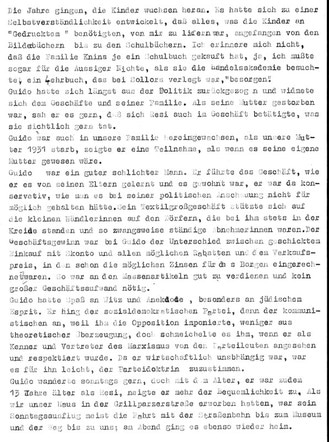 Page from my grandfather’s memoirs that also appears as front matter in "Jumping Over Shadows." Page from my grandfather’s memoirs that also appears as front matter in "Jumping Over Shadows." Those were the intersections of Jewish and non-Jewish life that interested my grandfather, and that he duly recorded in his memoirs because they affected him. I based a lot of my reconstruction of my great-aunt’s story on my grandfather’s memoirs, and specifically a chapter he titled “My Sister.” Very quickly, however, I realized that I needed to fill in the blanks if I wanted to contrast my story of falling in love with a Jewish man with my great-aunt’s. Who had he been? Who had his family been before they became connected with my family? In order to round out the story of this Jewish side of the family, I needed to know more about the Jewish community of Reichenberg. My first find, on the German eBay site, was this book on Reichenberg, published in Augsburg in 1974. I’m fortunate that I am fluent in German, and that my sister, who still lives in Germany, was willing to purchase the book for me. In it, I found several passages that corroborated other parts of my grandfather’s narrative, but it also included a chapter on “Die israelitische Kultusgemeinde in Reichenberg” (the Israelite Cultural Community in Reichenberg). Side note: To this day, Jewish communities in Germany, Austria and Switzerland are called “Israelite,” not “Jewish.” I have often had the impression that the word “Jude” (Jew) is hard to utter for Germans. 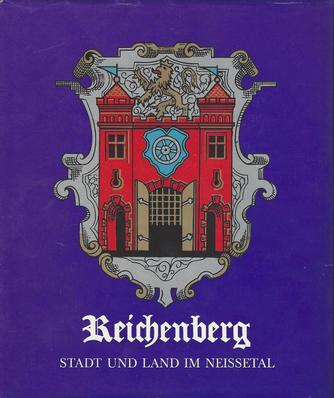 Book about the city of Reichenberg published in Augsburg, Germany in 1974. Book about the city of Reichenberg published in Augsburg, Germany in 1974. In seven paragraphs, this book summarizes the history of the Jewish community in Reichenberg. It was the usual sordid tale of rights granted and rescinded, coupled with various harassments, until Jews were given full citizenship by Austro-Hungarian Emperor Franz Josef in 1860, and 30 Jewish families took up permanent residence in Reichenberg. At the time, Reichenberg was a well-to-do center for textile and glass manufacturing and trade. However, these seven paragraphs didn’t give me any specific information on the family I was looking for. The chapter also featured this image of the “temple of the Israelite community.” Most importantly, for my research, it cited its source, an article written by Dr. Emil Hofmann, “Geschichte der Juden in Reichenberg,” published in 1934 (see above the picture where it says “Quellen:” – “Quelle” means source.) I was able to find this article, The History of the Jews in Reichenberg, in translation, on Jewishgen.org as part of a collection of articles titled The Jews and Jewish Communities of Bohemia in the Past and Present, edited by Hugo Gold and also published in 1934. Here I struck gold: “J.L. Knina” was listed as a member of the temple’s building committee. “J.L. Knina” was Joachim Ludwig Knina, father of my great-uncle Guido Knina. Further on, in a chapter titled “Jews in Non-Jewish Organizations,” I found Guido himself: From my grandfather’s memoirs I knew that he and Guido had served as city councilmen together. However, I did not know that Guido had been the first Jew elected to the city council. This is the kind of information that would be noteworthy to a Jewish audience but not to my grandfather. In addition, my grandfather was loath to label people—another reason, perhaps, why he makes no mention of this. This is where research is needed to fill in the blanks and find the information that is neither part of family lore nor contained in family documents. Ordering books, viewing them online, or borrowing volumes on Czech history from the library was, however, not enough. I had to hit the archives. On one of my trips to Reichenberg, in 2009, I went to the public library there, and asked whether they had newspapers from 1938. I thought if I could read reports from that time, I would be able to recreate what life had been like back then. The archivist shook her head and told me that it was unlikely they would have anything because there had been a fire at some point (Now the library is housed in a shiny new glass and steel building.). But she did put in a request and told me to return in two hours. When I got back, she gesticulated that they did have something, and after surrendering my American passport as a guarantee, she handed me a huge ledger of yellowed newspapers from 1938. Actual, physical newspapers! Thankfully, I can read the old Gothic-style German print; as a kid, growing up in Germany, I had been determined to read one of my favorite books, my grandmother’s volume of the saga of Rübezahl, a red-headed giant who lived in the forested mountains surrounding Reichenberg. Even though I knew that from September 1938 on, Die Zeit, Reichenberg’s city newspaper, had been a Nazi organ, it was still a fascinating read. The November 11, 1938 edition gleefully described the destruction of Reichenberg’s synagogue during Kristallnacht: Note here the particularly chilling subtitle: “Only the walls are left standing—the population protests the Jewish murderous attack” referring to the pretext for the pogrom of Kristallnacht, the assassination of German diplomat Ernst vom Rath by Herschel Grynszpan, a 17-year-old Polish Jew, in Paris on November 7, 1938. As far as I know, Guido never found out that the synagogue his father helped build went up in flames. He was already in a sanatorium, suffering from diabetes, and in and out of consciousness. My grandmother spent that day at his bedside. By that time, he and my great-aunt were divorced, presumably so she, the “Aryan,” could take over his textile business, save the family’s livelihood and ferry her half-Jewish children through the Nazi inferno. Most of Reichenberg’s Jews perished in concentration camps. I know of only one of Guido’s cousins, who made it to Palestine. My grandmother corresponded with her, and my husband and I visited her in Haifa on our first visit to Israel together in 1986. In 2012 (my manuscript was already finished), another book on the history of the Jews of Reichenberg was published: Reichenberg und seine jüdischen Bürger by Isa Engelmann, Berlin, 2012. It confirms the family story that Guido’s wife, my great-aunt Theresia (called Resi by my family), took over the business Joachim Ludwig Knina had founded in 1878 and that his son Guido had run until 1938: In order to keep up appearances, Resi had no contact with Guido after the divorce. Instead, my grandparents took care of him. They bribed the staff so he could stay in the sanatorium (Jews were barred from all kinds of institutions by then) and when he passed away in December 1938, they arranged for his funeral. Many years later, his son Ludwig, the only relative to remain in Reichenberg all his life, had my family’s and Guido’s grave put together because, after the war, German graves were regularly vandalized. Now the family gravestone only reads “Rodina Kninova” (Family Knina); unless you request to see the register for this particular grave, you would never know that my family members with the last name Berndt are also buried there:  Again, one piece of evidence, namely the grave, tells only part of the story. The associated document, if you do ask for it, tells another part of the story, namely that in fact more than just “Rodina Kninova” are buried there. But even that is only part of the story. Nowhere, except in my family’s oral history, will you find that Guido, buried here, was Jewish. It all needs to come together—artifacts, documents and lore—to round out the picture. And even then, I am not convinced it is the whole story. What remains of a life, of all lives, are always fragments. Once a subsequent generation finds these fragments, it depends on them, on how they piece them together, what story might be told of the past in the future. I, for one, stumbled upon one stunning fragment that could explain another tragic family story. For that tale, however, you will have to read Jumping Over Shadows.  Annette Gendler is the author of Jumping Over Shadows, the memoir of a German-Jewish love that overcame the burdens of the past. Her writing and photography have appeared in the Wall Street Journal, Tablet Magazine, The Forward, Kveller, Bella Grace and Artful Blogging, among others. She served as the 2014–2015 writer-in-residence at the Hemingway Birthplace Home in Oak Park, Illinois, and has been teaching memoir writing at StoryStudio Chicago since 2006. Born in New Jersey, she grew up in Munich, Germany, and lives in Chicago with her husband and three children. About a year ago at this time, I interviewed two recently emerged and international musical performers, Saul Dreier and Ruby Sosnowicz, of the “Holocaust Survivor Band.” For those of you who did not have the opportunity to read that blog, you may access it here. In the tradition of that piece, I decided to interview – this time in-person – yet another prominent name in the world of art and performance that also bears close ties to Yiddish and to pre-World War II Eastern Europe. The central figure in this month’s blog is that of Al Jaffee, who is perhaps best-known for his work as a writer-artist for the satirical American humor magazine, Mad (magazine). Readers and non-readers alike still recognize the long-running publication for its iconic mascot, “Alfred E. Neuman,” who continues to appear in some form or another on the magazine’s front cover. Mad’'s longest-running contributor is, in turn, Al Jaffee, whose work with the magazine debuted in 1955. Al has worked consistently for the publication since that time, with the exception of a brief period between 1957 and 1958, when he worked elsewhere. Indeed, in 2016, Al’s career earned him a place in the Guinness Book of World Records as the longest active comic artist.  Issue #30 (December 1956) of Mad, the first one to feature the magazine’s mascot, Alfred E. Neuman. (Courtesy of Wikipedia, accessed 3-24-17.) Issue #30 (December 1956) of Mad, the first one to feature the magazine’s mascot, Alfred E. Neuman. (Courtesy of Wikipedia, accessed 3-24-17.) However, what most people who have heard the name “Al Jaffee” do not know about him is that he has led not only a highly productive and creative life, but also a most unusual life, which began in Savannah, Georgia on March 13, 1921. One of the things that makes Al’s life less-than-typical is that his childhood was split between an American English-speaking world and a small-town Lithuanian shtetl life in which Yiddish was the lingua franca for the vast majority of Jews. Al’s parents, Morris and Mildred, had immigrated to the United States sometime before World War I from the remote and impoverished Lithuanian town of Zarasai (also known by several other monikers, including: Ežerėnai [Lith.], Ezhereni [Yid.], and Novo-Aleksandrovsk [Rus.]), and settled in Savannah, Georgia, where Morris Jaffee got a job at what was initially Blumenthal’s Pawn Shop. Subsequently, it became a department store, and Morris was given a managerial position. Then in 1926, Al’s mother, whom Al described as fervently religious and far more “old world” than his Americanized father, up and took Al and his three younger brothers with her back to Zarasai. This trip only lasted until 1927; but subsequently, in 1928/29, she once again took the children with her to her hometown in Lithuania. This trip was not intended to last a long time, yet it ultimately resulted in Al and his brothers spending several of their formative years in the town referred to by different sources as “The Switzerland of Lithuania.” The Jaffee family’s final year in Lithuania culminated in a period of residence in the predominantly Jewish Kovne (Yiddish for Kaunas) suburb of Slobodka. For those interested in the history of Jewish life in Lithuania, Slobodka is perhaps most often associated with the “Slobodka Yeshiva,” which functioned from ~1881 until the outbreak of World War II. Al’s sojourn in Zarasai and Slobodka lasted until May of 1933, at which time his father returned to Lithuania to reclaim his family. Al’s father saw the handwriting on the wall, as Adolf Hitler had just come to power in January of that year, and he insisted on bringing his family back to safer grounds in the United States. Unfortunately, Al’s mother refused to return to the United States or to allow her youngest son to return in the company of her husband and other sons to the United States. The youngest son was later brought out of Lithuania in 1940, scarcely before the outbreak of The Second World War. Al’s mother, however, was murdered with the roughly 95% of Lithuanian Jewry, in the Holocaust. During the time that Al spent in Lithuania, he spoke English at home with his mother and brothers, as this had also been their spoken language at home in Savannah. Al’s father was, in fact, quite fluent in English, and even wrote letters in English for other immigrants who had not (yet) mastered the language. Al’s mother also enjoyed reading English, and asked that her husband send English-language children’s books from the United States for their four boys. Somewhat surprisingly to me, Al remarked that back home in Savannah, his family spoke English – not Yiddish – nor did he hear Yiddish spoken during his time in Savannah. This, of course, presented certain linguistic challenges when Al and his family relocated to Lithuania. Yet, even as English was the spoken tongue of home life, it was not understood by the locals in Zarasai or Slobodka. As a result, Al also had to learn colloquial Yiddish, which he spoke with his relatives, his boyhood friends, and which was spoken at the Jewish school or “kheyder” (or “cheder”) that he attended. He also learned the language, along with Jewish, and more general subject matter, from a “melamed” – a tutor – who came to the Jaffee home. As Al recalled, life in Zarasai – with the large house his family rented, replete with a sizable orchard, bearing apples, pears, gooseberries, and other such delicacies – was much like an Eastern European Jewish version of the all-American Mark Twain novels. While growing up in Zarasai, which Al described as quite primitive – a place where nearly everything, including ink and fishing rods – had to be made from scratch – he would play, go fishing, and dig for skeletons from The First World War with his friends. All of this was conducted in an unsophisticated day-to-day Yiddish. Russian and a scant amount of Lithuanian, which Al remarked that he almost never heard aside from at the local post office, were also spoken on the streets. But among Jews, life functioned entirely in Yiddish. If one needed the aid of a Gentile policeman, for example, who invariably spoke Russian, Lithuanian, or Polish, it was necessary to somehow make oneself understood in one of these other tongues. Otherwise, though, this was the linguistic exception for Jews at that particular place and time – not the norm. When the Jaffee family relocated to Slobodka in 1932 to live near other relatives, Al once again had to employ the Yiddish-speaking skills he had acquired during his years living in Zarasai. Al’s uncle owned the local “Bango Theater,” a popular entertainment site that featured films and actors from all over, including: Gustav Fröhlich, a popular German actor and film director; Clara Bow, an American actress who started out in silent films and transitioned to “talkies”; Birth of a Nation; and Nosferatu, which totally spooked Al when he saw it in his uncle’s theater. According to Al, Slobodka was a generally nice place in which to grow up, barring the fact that as Jews, it was always necessary to be on one’s guard and wear one’s armor against the potential attacks of anti-Semitic Gentiles, both children and adults. Tragically, during World War II, Slobodka would become a true ghetto for Jews, manned by Lithuanian guards, and containing over 29,000 Jews. A significant number of these individuals were murdered in the nearby Ninth Fort, while others yet were deported to additional murder sites. 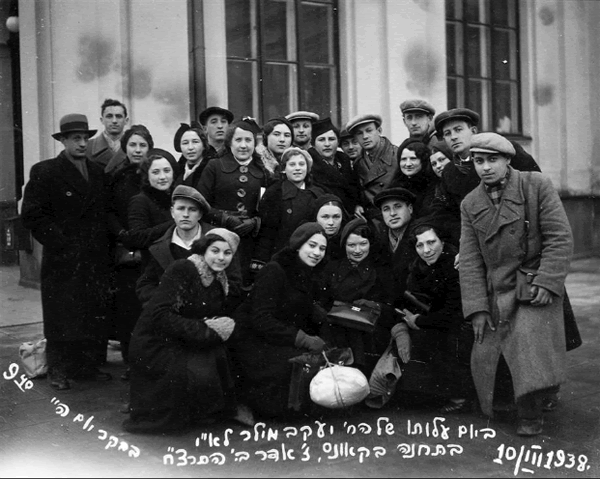 Members of Gordonia, a Zionist youth movement, accompany fellow member, Yaakov Miller, as he departs for Palestine from the Kaunas train station, 1938. Hebrew caption indicates that photograph was taken on the “7th of Adar 2,” specifically on “Thursday morning, 9:40 am.” (Courtesy of Eilat Gordin Levitan, accessed 3-24-17.) Notwithstanding the heavily Yiddish-oriented world in which Al found himself in Lithuania, he noted that the last time he actually spoke Yiddish was in 1933, at which time he – as a twelve-year-old child – returned to the United States. Nevertheless, as Al asserted, the seeds of Yiddish were evidently planted deeply enough, so that even today – all these more than eight decades later – he still often thinks in Yiddish. As he put it, “The language has many subtleties that can’t be expressed in other languages.” Al’s examples of this included the Yiddish word “tam,” which stems from the Hebrew: “ta’am.” Depending on context, the word can mean: taste, flavor, charm, or appeal. Another one of Al’s Yiddish-isms, one that was supposedly made up by Mad, was the off-color expression: “puts-rebe” (or “putz-rebbe”). This was apparently something that Al heard while growing up in Lithuania, and which was later appropriated by Al’s colleague, Harvey Kurtzman – who found the sound amusing – for their satirical publication. The expression was used in Lithuania, according to Al, to mean a “jerk of a teacher.” To this day, Al revealed, he is asked by Jews and non-Jews alike about the meaning behind the words. And yet another Yiddish expression that Al shared with me was: “Vos zogt der groyser knaker?” – meaning: “What does the big shot have to say?”  Front cover of June 22, 2016 issue of Mad. (Courtesy of Mad, accessed 3-23-17.) Front cover of June 22, 2016 issue of Mad. (Courtesy of Mad, accessed 3-23-17.) As for Al’s work as an artist-writer, this certainly predated his tenure with Mad. He was always artistic as a child – although, as Al conveyed, he does not enjoy “pretty art” – nor does he view art as a “holy business.” Rather, he sees it as a tool for communication and a vehicle for self-expression. But one of Al’s first major “breaks” in the field of artistic expression actually came from the military, when he served with the United States Army during World War II. It was during that time when he worked for the Pentagon and the Air Force Surgeon General’s office illustrating brochures, pamphlets, flow charts, and designs pertaining to physical exercises created and advocated by Colonel Dr. Howard Rusk (1901-1989), a leader in the field of physical therapy for both military personnel and civilians. Later on, Dr. Rusk and Bernard Baruch (1870-1965) would join forces to create the world-famous Rusk Institute of Rehabilitation Medicine in New York City, which continues to apply Dr. Rusk’s exercises to the medical and physical needs of civilian Americans to this day. During this same period of military service, Al came into contact with several other Jewish fellows serving alongside him, many of whom knew at least some Yiddish. One important figure in particular then was Captain Alfred Fleishman (1905-2002) of St. Louis, Missouri. Fleishman came from a Yiddish-speaking family that owned a company called “Fleishman Pickle Co.” Al recalls how Fleishman once took him to a kosher deli in Washington, D.C., and told him about his family. The two of them would throw around Yiddish terms; and from time to time, Fleishman would give him pickles that he had brought back with him from his family in St. Louis. Al made a point in stating that these types of interactions between different ranks in the military were fairly uncommon.  Front cover of August 20, 2008 issue of Mad. (Courtesy of Mad, accessed 3-23-17). Front cover of August 20, 2008 issue of Mad. (Courtesy of Mad, accessed 3-23-17). In looking for additional information about Captain Fleishman, I uncovered two online obituaries about him in The New York Times and the Los Angeles Times. Both of these articles attest to the fact that Fleishman cut a very decent and honorable figure, that his family operated a pickle company in Missouri, and that he was fluent in Yiddish. What came to light most, though, about Fleishman in those obituaries, is that following World War II, he was assigned by the United States military and the American Joint Distribution Committee (AJDC) – also known loosely as the “Joint” – to Austria and Germany. There, he interviewed Jewish refugees in Yiddish, collecting information for the United States government about how best to assist these individuals. Fleishman spent three months in displaced persons camps engaged in this work; and upon return to the United States, he went on a three-month national speaking tour, soliciting aid for the Jewish refugees. According to one of the obituaries, Fleishman considered heading the delegation to Germany and Austria as his greatest accomplishment. In closing, although he does not continue to speak Yiddish on a regular day-to-day basis today, as he once did in Lithuania many years ago, Al Jaffee still feels driven in his work and in his life by the “Yidishkeyt” (or “Yiddishkeit”) to which he was already exposed during his most formative years. If you have any Yiddish materials – humorous, satirical, or otherwise – that you would like translated, please feel free to contact me at: rivka@rivkasyiddish.com. For those of you who are new to my blog or simply did not have a chance to read my previous post: “Wrestling with Identity: What Happens When Old Country Meets New?,” in which I highlighted several of the major themes and subjects that appear in the documents that I have translated over the past nearly 20 years. One of the main themes that I discussed in that blog was the growing divide that I frequently witness between the older generation – the one that is typically more tied to the “Old World” – and the younger generation – usually the one that is more linked to the “New World.” One of the chief forms of that growing divide may be seen vis-à-vis the traditional, religious observance of Judaism, often referred to as “Yidishkeyt” (literally: “Jewishness” in Yiddish). With the shift from one generation to the next, along with the migration from the “Old Country” to the “New Country,” the threads of religious observance oftentimes unraveled – sometimes, in fact, at a rather quickened pace. Due to space constraints, I was previously unable to showcase all of the examples that exemplified the aforementioned pattern of religious and generational divide, which I had in mind for a single blog. As such, I would like to include in the following, the other excerpt I recently translated for a client from the original Yiddish letter that I left out of my January blog. I am certain that this is a theme that is prevalent in the history of many Jewish families that migrated from Eastern and Central Europe to other parts of the world – the United States, South America, and Palestine (later, Israel) – to name a few. Ironically, this divide is also a theme that continues to repeat itself even today, albeit not necessarily in the same form or manner. Translation Follows: p. 2 With God’s help Warsaw, 1939 …. And now, with regard to my child, I believe that I don’t need to praise her. One must have a good husband for her. The world says that for good things, every person is a man [or possibly a husband]. However, that is not the case … Certainly you know, my son-in-law, and you see what it is to conduct oneself Jewishly. Can you take it upon yourself to lead a pure Jewish life, seeing as I don’t believe that my dear daughter will be able to bear it any other way than what she witnessed [while growing up] in my home? And given that I see that you certainly want her, you love her, this is the first thing [i.e., the matter of utmost concern] that she wants … such that [she] does not want to have any hardship and … one with your leading a Jewish lifestyle. Don’t think that I am such a fanatical person or from such a fanatical family. One can see that from my children and from my sister. But still, the first thing [i.e., highest priority] is a Jewish lifestyle. I have a great deal to write about that, but I believe that you understand what I mean. That having been said, write me whether you can undertake this. At that time, I will agree.  “In Commemoration: 1925,” cover of booklet of postcards in Hebrew and Yiddish commemorating the building of the Hebrew University of Jerusalem, which the daughter of this letter's author attended in then-Palestine (Warsaw: Jewish National Fund, 1925). (Courtesy of Kedem Auction: https://goo.gl/JfRNfX, accessed 2-7-17.) “In Commemoration: 1925,” cover of booklet of postcards in Hebrew and Yiddish commemorating the building of the Hebrew University of Jerusalem, which the daughter of this letter's author attended in then-Palestine (Warsaw: Jewish National Fund, 1925). (Courtesy of Kedem Auction: https://goo.gl/JfRNfX, accessed 2-7-17.) The above translated excerpt was written by a father in Warsaw, Poland on the brink of World War II, to his future son-in-law in Palestine (also frequently referred to as “Eretz Yisrael”). The father is essentially writing here to his potential son-in-law that he will only grant him his blessing to marry his daughter if the young man is prepared to live a traditional Jewish lifestyle – one that his daughter grew up observing in his household. It is also clear from the translated excerpt that if the potential son-in-law were to respond negatively to the author’s demand, he would not be given a blessing to marry the letter writer’s daughter. As evidenced by other letters written by the same author to the identical son-in-law-to-be, the author wanted the young man to quit his current job and get another one that would allow him to observe the Jewish Sabbath by not requiring him to work then. According to my client, the author’s daughter (my client’s mother) and future husband (my client’s father) came from vastly different backgrounds, though they were both born and raised in Poland. She hailed from an upper-middle class Warsaw family that was religiously observant and was herself well-educated. Conversely, her young man came from a non-religious working class family from Pabianice, a town in the vicinity of Łódź. His education ended by the age of 14, at which time he went to work. He became a hairdresser, often servicing clients who were not Jewish. In contrast, she was accepted to study at the Hebrew University in Jerusalem, which in part, prompted her to move to Palestine in 1936. As a postscript, my client informed me that her parents – in spite of whatever differences they may have had – married on June 4, 1939 – within close proximity of when this letter was written. Theirs, according to my client, was a happy union that lasted nearly 50 years. As my client expressed to me, her mother always remained a little bit more religious than her father. But this did not adversely affect their many years together. Aside from the themes about which I have now written, I imagine my readers would also like to know something about the characters who appear in the family letters and other documents that I encounter in my translation work. Not surprisingly, the vast majority of the texts I read pertain to common “everyday” Jews in countries such as Poland (the largest number hail from there), present-day’s Ukraine and Belarus, Romania, Slovakia, Czech Republic, Russia, England, South America, South Africa, Palestine and Israel, and the United States. The characters who are given life – indeed, resurrected and immortalized – through their own words, are frequently businessmen such as the above example, written in Warsaw on the verge of World War II. In numerous other cases, the author is a woman – often a mother writing to one or more of her children – as seen in the example portrayed in my previous blog, written in 1920s’ Kraków. Siblings, grandparents, and other close family members are also included in this lineup of correspondents. However, over the years, I have also occasionally found references to well-known historical figures of various bents: writers, politicians, explorers, victims, heroes, and villains. Some of these individuals are still remembered today, even though they may have lived more than a century ago. It is about a few of these figures that I will now elaborate. 1) Roald Amundsen (1872-1928) – This sturdily-built Norwegian explorer who called himself “the last of the Vikings” was the first person to reach the South Pole on December 14, 1911, which he named Polheim – Norwegian for “Pole Home.” Initially, his country, the rest of the world, and even his own crew, thought that Amundsen’s intended goal was the North Pole. His crew only learned of the true target site when their ship was well off the coast of Morocco and Amundsen announced that they were not headed for the North Pole, but to the South Pole. Amundsen and his crew returned to their base camp some 99 days and 1,860 miles after their departure. Amundsen also achieved other great feats, including successfully sailing through the Northwest Passage in 1903 and flying over the North Pole in 1926. He was ultimately killed while flying on a rescue mission in 1928 over the Arctic Ocean. Ironically, only that same year, he was quoted by a journalist as saying the following about his beloved Arctic: "If only you knew how splendid it is up there, that's where I want to die." No offense to the Norwegians (and perhaps Americans of Norwegian stock), but in all honesty, I wonder how many people today even recall this modern-day Viking. When encountering this name in one of my family letters, I was subtly reminded of one of our local Chicago high schools – “Amundsen High” – about which I had heard while growing up there. But even so, I, too, needed to refresh my memory by reading up on Amundsen. Here is a snippet of the reference to Amundsen that I translated from the original Yiddish in an undated letter written in a reprimanding tone by one brother in Europe to another brother, “Yisroel,” in America: “…. Finally, after such a long [period] of silence, you once again remembered and took a little time, and wrote your brothers a letter. As I see it, in America, it is very hard work to write a letter. One must wait for a letter for a good couple of months. Just like Amundsen, who focuses his speech on the North Pole. Certainly, you know who Amundsen is.” Based on the above excerpt, it is evident that in his day – the early 20th century – Amundsen was clearly a celebrated figure on both sides of the Atlantic. Similarly, this correspondence also reflects the misinformation that the world had up until the time that Amundsen’s voyage was already underway, regarding the North Pole being his goal. Perhaps it is also worth mentioning that Amundsen is among the very few famous Gentiles I have encountered in my readings and translations over the past nearly 20 years. I suppose that that in itself speaks loudly for this man’s monumental – albeit unfortunately, little remembered – achievements.  Undated photo of Symon Petliura (1879-1926) (courtesy of Wikipedia: https://goo.gl/jf7Xme, accessed 2-3-17). Undated photo of Symon Petliura (1879-1926) (courtesy of Wikipedia: https://goo.gl/jf7Xme, accessed 2-3-17). 2) Symon Petliura (1879-1926) – Unlike Amundsen, Petliura established a highly negative reputation for himself among Jews, Poles, Bolsheviks, and other political and ethnic groups. It is Petliura, General Secretary of Military Affairs of the Ukrainian People's Army – or at the least, his military forces – who is credited for instigating many of the anti-Jewish pogroms that accompanied the Russian Revolution of 1917 and the ensuing Russian Civil War. According to death counts at the time, “it was estimated that at least 30,000 Jewish men, women and children were massacred in Ukrainian towns by Petlura’s forces” (Jewish Telegraphic Agency, May 27, 1926, accessed 2-2-17). Ultimately, Petliura was assassinated by a Jewish anarchist and Yiddish poet named Sholom Schwartzbard (1886-1938) on May 25, 1926, while strolling in Paris. Schwartzbard purportedly committed this act to avenge the murders of all his close family members during the pogroms of 1919-1920. Schwartzbard was acquitted by a Parisian court, and the murder trial – a cause célèbre of its day – emerged as a political case against the Ukrainian government. Today, Petliura is honored and remembered by the Ukrainian people as a national martyr and hero – one of their leading modern-day freedom fighters. As for Schwartzbard, he was aided by Jews the world over for what many of them considered an act of true heroism and justice. A committee was even formed for this very purpose in Chicago, aptly named the “Sholem Shvartsbard komitet” (or “Sholom Schwartzbard Arrangement Committee”). Indeed, it was this same committee that published Schwartzbard’s two autobiographical works in Yiddish: In krig mit zikh aleyn (“At War with Myself”) (1933) and In’m loyf fun yorn (“Over the Years”) (1934). This controversial, so-called modern-day avenger of justice for Jews, died on March 3, 1938 in Cape Town, South Africa while on a trip to raise funds for the publication of a Yiddish encyclopedia. As per his will, he was later reinterred in Israel. The Shalom Schwarzbard Papers, 1917-1938, may be accessed today at the YIVO Institute for Jewish Research in New York City.  Images and police paperwork of Sholom Schwartzbard (1886-1938) at the time of his assassination of Symon Petliura, Paris, France, 1926 (courtesy of Russia House News: https://goo.gl/ld6Wp5, accessed 2-7-117). Images and police paperwork of Sholom Schwartzbard (1886-1938) at the time of his assassination of Symon Petliura, Paris, France, 1926 (courtesy of Russia House News: https://goo.gl/ld6Wp5, accessed 2-7-117). The following is but a brief excerpt regarding Petliura’s pogromist bands, which I translated from Sefer Burshtin (“The Book of Bursztyn”), the memorial book of a town that is located today (c. 2017) in the Ukraine: During the years 1917-18, at the end of the First World War, fights continued for a long time between the Ukrainians, Poles, and Bolsheviks in the Bursztyn area. Because of its strategic placement, Bursztyn sustained a key position. It is clear that the scapegoat was always the Jewish population. Everybody tore pieces from them. Whichever army went through there robbed and raped Jewish women, filling the town with wailing. The women were raped in the presence of their husbands, parents, and children. The most heavily felt in the town were the Petliura-ists. Jewish life was utterly abandoned. In the pogroms and rapes there was participation both by the Ukrainian peasants and the intelligentsia, who demonstrated the lowest degree of animalism and sadism (pp. 147-148).  Mendel Beilis (b. Russian Empire, 1874-d. United States, 1934) (courtesy of the Forward, Dec. 18, 2013: https://goo.gl/lDT1iY, accessed 2-3-17). Mendel Beilis (b. Russian Empire, 1874-d. United States, 1934) (courtesy of the Forward, Dec. 18, 2013: https://goo.gl/lDT1iY, accessed 2-3-17). 3) Mendel Beilis (1874-1934) – A contemporary of the aforementioned noteworthy figures, Beilis is yet another name that has crept into the texts that I have translated. Without going into the elaborate details about him or his trial, suffice it to say that he was at the center of yet another cause célèbre, like Sholom Schwartzbard. However, in Beilis’ case, he was unquestionably a martyr, wrongfully accused of murdering a 12-year-old Andrei Iushchinskii in Kiev. The claim at the time by anti-Semitic hordes, members of the then Czarist government, and other members of Russian society, was that this was a typical case of blood libel that Beilis had perpetrated against an innocent Christian youth. Short of revisionists and anti-Semites, I would contend that there has been unanimous agreement among scholars, journalists, and laypersons in the West, that Beilis was scapegoated for an act he never committed. The reason being, was because he happened to live and work close to where the murdered boy was found. Moreover, Beilis was the only known Jew in the vicinity. This was the key point of significance, given the highly anti-Semitic regime and atmosphere that existed at the time in Czarist Russia. Beilis was arrested shortly after the victim’s body was discovered, and he languished in a squalid prison cell for over two years. His court case – by all accounts a kangaroo trial – took place in Kiev and lasted from September 25 through October 28, 1913. Thankfully, Beilis was finally acquitted of the crime, though the so-called Jewish institution of blood libel was not deemed to be fallacious. At the time, Beilis’ fate was documented in numerous newspaper articles and featured in many postcards. The international Yiddish press was certainly included among those periodicals and ephemera. In the aftermath of the acquittal, Beilis and his family tried to settle in Palestine, but ultimately immigrated to the United States. There, he wrote a memoir about his experiences in 1925, entitled (in Yiddish), Di geshikhte fun mayne layden (“The Story of My Sufferings”). The royalties of the book – which was also translated into English – helped sustain Beilis and his large family financially during his final years. Beilis died unexpectedly in Saratoga Springs, New York on July 7, 1934 and was buried in the same cemetery in Queens, New York, as the renowned Yiddish writer, Sholem Aleichem (1859-1916). 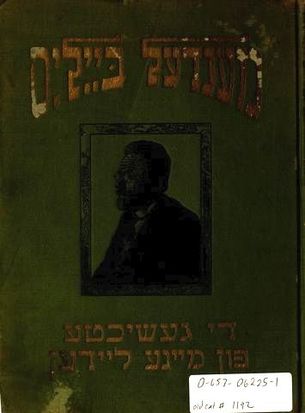 Di geshikhte fun mayne layden (“The Story of My Sufferings”) (1925) by Mendel Beilis (courtesy of the National Yiddish Book Center: https://goo.gl/HyvbHS, accessed 2-3-17). Di geshikhte fun mayne layden (“The Story of My Sufferings”) (1925) by Mendel Beilis (courtesy of the National Yiddish Book Center: https://goo.gl/HyvbHS, accessed 2-3-17). The following is a terse, but highly revealing excerpt from a family letter I recently translated from the Yiddish. The author’s words patently convey that emotions ran high – particularly among Eastern European Jews – during Beilis’ trial. Up until his acquittal, there was always the much warranted fear that Beilis would be found guilty and made to suffer the consequences of such a conviction. Written by Dawid Srebnagóra, in Płońsk, Russian Empire only one day before Beilis was found innocent – to various family members: Płońsk October 27, 1913 p. 3 When I returned home from Płock, I became seriously ill. I made use of doctors and medications. I had recited blessings for Beilis’ procurator. I am now taking a pen in my hand for the [very] first time, and my hand is still shaking. When I read the above words, I initially did a “double take” on the surname mentioned here, and then set out to confirm that this was indeed a reference to Mendel Beilis. I was somewhat stunned (though my hands were not quite shaking) to learn that this letter was written only a matter of hours before Beilis’ long-awaited acquittal and freedom. These are only a smattering of the larger body of famous and not-so-famous names I have encountered in the texts that I have read and translated over the years. Some of the other names that I will mention only in passing, are: Golda Meir (1898-1978), Israel’s first and only female Prime Minister to-date; and the Bielski Brigade, a network of Jewish partisans led by members of the Bielski family of Nowogródek, Poland, from 1942 to 1944 in Western Belarus. They singlehandedly succeeded in rescuing more than 1,200 Jews from an almost certain death. The Bielski Brigade entered the public sphere only as recently as 2009, in the film, Defiance, based on Nechama Tec’s book, Defiance: The Bielski Partisans (1993). I look forward to the diverse and many-faceted personalities I will surely encounter in my future translation assignments. Furthermore, I hope to have the opportunity to share those additional Yiddish translator’s discoveries with you, my readers. Should you have any documents pertaining to famous or not-so-famous individuals, or any other materials that you would like translated from the Yiddish, please do not hesitate to contact me at: rivka@rivkasyiddish.com. My clients often ask me about the type of themes and subject matter that I encounter in my unusual line of work. In the nearly twenty years since I began translating Yiddish texts, I have definitely found certain themes that are relatively common and widespread among family letters, in particular. In thinking this over recently, I was able to break down those frequent topics of correspondence into the following general groups: 1. Shortages of money and/or food – This is especially prevalent in letters written in Eastern Europe during times of economic depression, and/or warfare (e.g., World War I and II). Since many of the letters I encounter stem from the interwar period, I can say without question that these hardships become increasingly pronounced during the final years and months leading up to The Second World War. In certain instances, this coincides quite blatantly with the anti-Jewish laws that were enacted against Jews in large swaths of Eastern Europe. 2. Instructions regarding maintenance of the family business – Be it about business conducted in Europe (the proverbial “Old Country”) or already in the United States, South America, Palestine – “Eretz Yisrael” – or elsewhere (the proverbial “New Country”), this is a theme that frequently repeats itself – generally between fathers and sons, brothers, and other male family members. Only in rarer instances have I seen female family members included in these financial discussions. 3. Hope that the family will soon be reunited in the “New Country.” In the current state, the family is fragmented, divided between different continents – the “Old Country” versus the “New Country.” Occasionally this division is simply between different cities within the “Old Country.” It is entirely common to find the “Almighty’s” name invoked here. Many parents and grandparents (and other family members) often write something akin to: “I hope that the blessed Lord will help me in seeing you in-person, once again.” Sometimes the invocation is even more dramatic and imploring: “May I still lay eyes on you one last time before I depart this earth.” 4. Illness and death – References to family tragedies and misfortunes are not wholly uncommon. Usually these subjects are mentioned in conjunction with the worsening physical state of a parent or grandparent (or other close relative) and/or news of his/her untimely death. Sometimes this is clearly linked to the generally nefarious condition for Jews in Eastern Europe prior to (and leading into) the Holocaust. At times, when the letter is directed at a son, he is entreated with the responsibility of saying Kaddish (the Jewish prayer for the dead) and observing the seven-day period of Shiva (the time allotted within traditional Judaism for mourning). Traditionally, it was the obligation of the son/s to recite Kaddish for a year following the death of a parent. 5. Maintenance of religious traditions, primarily in the migration from the “Old Country” to the “New Country.” It was well-known that America, in particular, was not so much the proverbial “Goldene Medine” (Golden Land) - referenced by the likes of Jewish immigrant writers such as Anzia Yezierska (1880?-1970) in Hungry Hearts and other related works. Rather, for many Jews, America represented the “Treyfe Medine” (Unkosher Land) – at least for those Jews who continued to adhere to traditional, religiously observant Judaism. This realization on the part of Jews who remained behind in the “Old Country” regarding the decline of religious observance set in as early as the turn of the previous century. What’s more, it lasted right up until the outbreak of World War II. This is reflected in several letters that come to mind from the interwar period, usually written by admonishing parents to their children who had already immigrated to the “New Country” (mostly, from the letters I have translated, the United States).  “New Country”: Scene of the Lower East Side of New York City, turn of the 20th Century. Note that none of the adult males depicted here – many, if not all of them, likely Jewish immigrants – have beards, a typical mark of a religiously observant adult Jewish male. Also note that in many cases, business and shop signs bear Yiddish advertisements (sometimes, without the accompanying English translation). (Courtesy of the Tenement Museum New York: goo.gl/1Ob7Xw, accessed 12-31-16.) Anecdotally speaking, I will never forget a vignette my grandfather related to me vis-à-vis the perceived decline of observant Judaism in the “New Country,” in contrast with that of the “Old Country.” According to my grandfather, who was born in Kielce, Poland in 1904 – prior to such historical events as the sinking of the Titanic (which my grandfather recalled) and World War I (which, for some reason, my grandfather never mentioned to me) – there had been a local Jew in his community who had actually “gotten out” before World War II (my grandfather’s words) and come to America. Yet unbelievably, he returned to Kielce sometime during the interwar period, because as he informed the local Jewish community, it was impossible to maintain one’s “Yidishkeyt” (observance of traditional Judaism) in the “New Country,” as it was entirely “treyf” (unkosher). Cases in point of this growing religious divide between the older generation in the “Old Country” and the younger generation in the “New Country” may be seen for example, in some of the entries in the Forverts' /Yiddish Forward’'s advice column, known as “Dos Bintel Brief.” The column, which in Yiddish, literally means “The Bundle of Letters,” ran for over 60 years (from 1906 until at least 1970), and doled out various forms of advice regarding the struggles and woes of Jewish “greenhorns” – and their offspring – in the United States. The following abbreviated excerpt is but one such case highlighting this very divide: 1908 Worthy Editor, I have been in America almost three years. I came from Russia where I studied at a yeshiva. My parents were proud and happy at the thought that I would become a rabbi. But at the age of twenty I had to go to America. Before I left I gave my father my word that I would walk the righteous path and be good and pious. But America makes one forget everything. Here I became an operator, and at night I went to school … entered a preparatory school, where for two subjects I had a Gentile girl as teacher… I don’t know what I would have done without her help. I began to love her, but with mixed feelings of respect and anguish … and I never imagined she thought of marrying me… Then she spoke frankly of her love for me and her hope that I would love her… I was confused and I couldn’t answer her immediately. In Europe I had been absorbed in the yeshiva … She is pretty, intelligent, educated, and has a good character. But I am in despair when I think of my parents. What heartaches they will have when they learn of this! I asked her to give me a few days to think it over. I go around confused and yet I am drawn to her. I must see her every day, but when I am there I think of my parents and I am torn by doubt… Respectfully, Skeptic from Philadelphia (A Bintel Brief, edited and with an introduction by Isaac Metzker. New York: Ballantine Books, 1972, pp. 77-78.) In contrast to the above categories, I may also add here – should the reader be wondering about themes that are scarcely discussed in the letters that I have translated – that I have a brief list, as seen in the following: 1. Serious financial corruption and fall-out within families; 2. Family members marrying outside of the Jewish faith; 3. Marital indiscretions, illegitimate births, abortions, and the like. Perhaps not surprisingly, this category, as well as the previous one, are typically referred to in rather euphemistic terms. I would like to focus on the last category of my most frequent themes in my current blog (“Maintenance of religious traditions”), as it is a subject that has appeared with greater recurrence in letters that I have translated recently. In order to shed further light on this phenomenon, I shall provide one excerpt here from some of these letters – to be continued (ideally) in my next month’s blog. However, in order to honor the privacy of my client, names have either been omitted or changed here. p. 1 With God’s help November 25, c. 1920s, Podgórze (Kraków) Dearest daughter, Lea, I received your letter today. Your words shook my heart, such that I could not calm down from crying. I had joy and suffering. For every word, I wished [you] well; that everything should always go well for you, and that my eyes should yet see you. For you recognize your sin. Therefore, the blessed Lord will forgive you; and I forgive you, as well. I am very glad that you are living a Jewish lifestyle. The blessed Lord will always help you… p. 2 …. And that which you write, that Rifke says that since you write, she need not also write … Were she still to have feelings toward her parents. But I see that her feelings have already been extinguished. The most significant thing is that she does not live a Jewish lifestyle, so she has no heart to write her parents. She must wrangle with the fact that nobody lives forever; not be [unduly] proud about her little house, seeing as her father had more than she has. And she did not take anything with her, now that she had an opportunity to do penance [i.e., for the sins/wrongdoings she did to her parents and in not living a Jewish lifestyle] and left it to you [i.e., that “you” should be responsible for writing, since she has no heart to do so]. Thus, I do not envy her. As I learned from my client regarding the above excerpt, which I translated from a larger body of text, the author of this letter was a very pious woman. Several of her children were already living in the United States at the time when she wrote these words to one of her daughters. The author, known by her descendants as “Bubbe [Grandmother] Dina,” was quite adamant that her children maintain their religiously observant lifestyles – regardless of whether they were now living in a more “open” and less Jewish environment overseas. What disturbed her most, though, as my client related, was that one of her daughters – Rifke – had decided to marry a man who was not religiously observant. The family’s oral tradition was that Rifke had always been “the rebellious child” – the one who had distanced herself from the rest of the family, stopped observing the Jewish Sabbath, keeping kosher, and the like. As such, my client was not in the least bit surprised to read (in translation) these admonishing words of “Bubbe Dina” regarding Rifke’s not living a “Jewish lifestyle.” The above letter excerpt – translated from the original Yiddish – is but a small window into the types of subject matter that I frequently encounter in my work as a Yiddish translator. In my next blog, I will pick up this subject again – and possibly some of the other themes I mentioned above. As one can see from the words expressed here, there was an evident growing divide – certainly along the lines of religious Jewish observance between the older and younger generations, even within close-knit families. This divide was all the more blatant when the older generation (that generally constituted the authors of the letters that I receive) still remained behind in the “Old Country” and the younger generation had already immigrated to the “New Country.” I would imagine that many of my readers are familiar with this phenomenon within their own families. As such, I invite you to please share you own accounts of this particular theme in your comments following my blog post. I am always interested in and intrigued by reading about such family “sagas” in my work as a Yiddish translator.  “New Country”: Delancey and Essex Streets on the Lower East Side of New York City, c. 1908. This was formerly one of the most prominently Jewish immigrant neighborhoods in all of New York. Faint Yiddish advertisements may be seen in the background. (Courtesy of Old NYC Photos: oldnycphotos.com: goo.gl/jr5agn, accessed 12-31-16.) Should you have any such family letters pertaining to any of the subject matter discussed here or beyond that you would like translated from the Yiddish, please do not hesitate to contact me at: rivka@rivkasyiddish.com.  “Old Country, New Country”: Illustration that may be interpreted to represent the stark contrast between the “Old Country,” as demonstrated by the lone traditional Jewish shtetl fiddler situated amidst the large and looming urban landscape of the “New Country” (in this case, New York City). (Courtesy of Timeline Touring: http://timelinetouring.com/images/fiddler.jpg, accessed 12-31-16.) Growing up in a family environment in which Yiddish was yet another vernacular spoken language along with English, I was exposed from a very early age to Yiddish songs and even nursery rhymes, which were generally sung to and by my younger siblings and me. Indeed, some of my earliest memories include dancing and singing along to records of Klezmer music that played on our record player. The songs amplified on that old and overworked record player included Yiddish language singers that were especially popular (and several of whom are still musically active today) in the early-to-mid-1980s – musicians and vocalists such as Henry Sapoznik of the then Klezmer ensemble, “Kapelye”; Chava Alberstein; Dudu Fisher; Mike Burstyn; Hankus Netsky of the Klezmer Conservatory Band; the late Barry Sisters; and the recently deceased, Theodore Bikel (1924-2015). It has been some time since I have heard those songs played with any regularity – and certainly not on a record player or tape recorder, for that matter – in our age of CDs, YouTube, and the like. However, in recently surfing the selections of Klezmer music available today on YouTube, I am reminded of specific songs that were once so familiar to me – and likely very familiar to many of my readers, as well: (and here, I am using the most commonly used orthography for these songs) “Rumania, Rumania,” “Mayn Shtetele Belz” (“My Small Town of Belz”), “Der Rebbe Elimelech” (“The Rabbi Elimelech”), “Papir iz Dokh Vays” (“Paper is Still White”), “Oyfn Veg Shteyt a Boym” (“On the Road Stands a Tree”), “Tumbalalaika” (“Play Balalaika”) and a host of others that are simply too many to include here. If you were to ask me which of these numerous songs I considered my favorite, I would be hard-pressed to answer you. It really depended on the given day and my particular mood at the time. And all these years later, I still feel exactly the same way.
 My sister Mindy’s rendition of our great aunt’s pflaumenkuchen, baked in honor of the autumn Jewish High Holidays. (Courtesy of Mindy Schiller, September 2015.) My sister Mindy’s rendition of our great aunt’s pflaumenkuchen, baked in honor of the autumn Jewish High Holidays. (Courtesy of Mindy Schiller, September 2015.) As far back as I can remember, one of the hallmarks of the upcoming autumn Jewish High Holidays for me were Rosh Hashanah, or Jewish New Year greeting cards. Of course, this accompanied the other signs of the season – namely, the honey cake (often called lekakh in Yiddish) my mother made à la the late Fanny Opper; my grandmother Tola’s apple cake (that was not limited only to this time of the year); my great aunt Lola’s pflaumenkuchen (or plum cake, which we always called flomenkikhen in Yiddish) – acquired during the period when she lived in Germany following World War II – and the decorations that my younger siblings and I would make for our family’s sukkah – or suke, in Yiddish [i.e., a booth or hut-like structure used during the holiday of Sukkot. Rosh Hashanah greeting cards, though, served multiple functions in my home. Not only did we send and receive these lovely reminders of the upcoming Jewish New Year holiday (and beyond), but we also used them as decorations from one year to the next in our sukkah. My father would collect all of the greeting cards that we had received in the days and weeks leading up to Sukkot – Sukes in Yiddish – or frequently called the “Feast of Tabernacles” in English – and take them to a nearby teacher’s center where he would have the cards laminated in large sheet form. We would then string these sizable swathes of laminated cards alongside the inner walls of our tarp-covered sukkah. This served as a festive and visually stunning reminder of holidays gone by and of all the friends and relatives whose names were attached to these mementos of yesteryear. Although most of the cards I saw over the years growing up in the United States in the 1980s and 1990s were in English and Hebrew, here and there we would also receive cards bearing Yiddish greetings. Mainly, I would see the handwritten messages scrawled upon the greeting cards my grandmother and great aunt received respectively from their cousins Yedis and Diana in Israel, and Rebeka in Brazil. Since they had all come from Warsaw, but subsequently lived in different countries and were not all equally well-versed in Polish, English, Hebrew, or in Portuguese, for that matter, Yiddish was their main written lingua franca. I always marveled at how these women had steadily managed to retain their ties to one another, even though they had not seen each other for so many years, and were divided both by time and space. Furthermore, I was impressed that Yiddish served as their common conduit of communication – even though they probably used it little in its written form in the years following their respective transmigrations from Europe, both before and after World War II. Those cards, in particular, were a sort of keyhole for me into another world – or, at least, into the remnants of that other world – and I could appreciate just how precious they were.  The Yiddish message printed on the upper right-hand side of this serene-looking Jewish New Year card reads: “Wake up, take a New Year now! God unlocks treasures, might and joy, and He will add days of happiness, and He makes your life bright!” (Courtesy of www.defendinghistory.com, accessed 9-25-16.) These are some of my personal associations with Rosh Hashanah greeting cards and the autumn Jewish High Holiday season (that is now upon us) going back to my childhood. But more recently, I began to wonder about the actual history surrounding these cards – when did they originate and where, and how have they changed and developed over time? Now that I have read up somewhat on the subject, please allow me to share a few of my findings with you in my most current blog. Also, given that my blogs pertain to my forays into Yiddish, I have included a montage of Rosh Hashanah greeting cards here that highlights the use of Yiddish – in addition to some of the other languages more widely used for this purpose today – namely, English and Hebrew.  This 3-dimensional Rosh Hashanah greeting card is clearly quite Zionist in its orientation, given that the Yiddish on the front and verso sides of this artwork (across the top, in gold print) reads: “Panorama of Tel-Aviv” and the front side includes a woman waving an Israeli flag of sorts, while surrounded by the beautiful scenery of Israel. (Hebrew Publishing Company, c. 1906-1912, New York, United States (Germany?); courtesy of Yeshiva University Museum: www.yumuseum.org, accessed 9-25-16.) Remarkably, the custom of sending Jewish New Year greeting cards dates back considerably – all the way to the Middle Ages – thereby significantly predating the Christian New Year card tradition, which only became popular in Europe and the United States during the 19th century. Among the earliest references to this Jewish custom is that of a recommendation made by Rabbi Jacob Moellin (c. 1365-1427; also known as the “Maharil”), spiritual leader of German Jewry in the 14th century in his work, Minhagei Maharil (First edition compiled by one of the “Maharil’s” students; Sabionetta, 1556). It is there that Rabbi Moellin is quoted as saying that during the Jewish month of Elul – the month that paves the way to the autumn High Holidays – letters should contain the Hebrew blessing: "כתיבה וחתימה טובה" which means: “May you be inscribed and sealed for a good year.” This message has subsequently become one of the most standard expressions used during the days leading up to Rosh Hashanah, and it is included in many holiday greeting cards even up until the present. 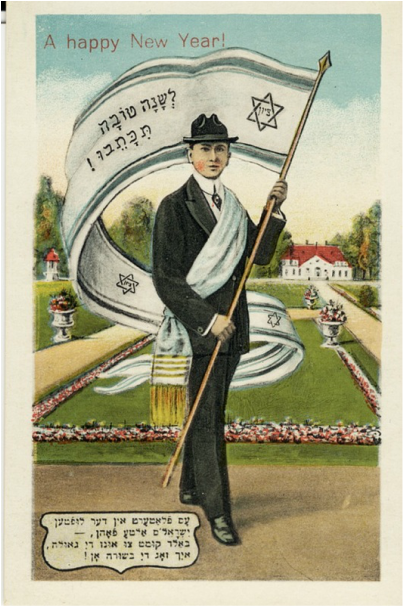 The Yiddish caption on the bottom of this pro-Zionist Jewish New Year greeting card reads: “Israel’s old flag is fluttering in the wind – soon, the redemption will come to us; I am announcing the news!” (Courtesy of www.blogspot.com, accessed 9-25-16.) The Yiddish caption on the bottom of this pro-Zionist Jewish New Year greeting card reads: “Israel’s old flag is fluttering in the wind – soon, the redemption will come to us; I am announcing the news!” (Courtesy of www.blogspot.com, accessed 9-25-16.) Thus, this custom originated among Ashkenazi Jews of the German Lands, and then gained momentum elsewhere, as well – ultimately reaching Sephardic and Oriental (or “Mizrachi,” in Hebrew) Jews in more recent generations. What helped to further popularize this practice was the invention of the “correspondence card” (or a postcard without a picture) in Vienna in 1869 and the illustrated postcard that took off during the so-called “Great Post Card Craze” (a title coined by Puck magazine in 1906), which spanned roughly from 1898 to 1920. During this “Craze,” the Jewish New Year greeting card also became more widespread in three major regions: Germany, Poland, and the United States. The German-produced cards frequently bore biblical themes, while those printed in Warsaw, for example, tended to exhibit nostalgic Eastern European Jewish religious scenes. The latter greeting cards even made use of amateur actors who modeled for multiple such illustrations. I suspect that this may have been the case in the following Jewish New Year greeting card, which features a man and a woman who appear familiar to me from other, similarly designed Rosh Hashanah greeting cards that were likely printed in the same unaccounted for time period and place as this one.  The Yiddish caption on the lower left-hand side of this Jewish New Year greeting card reads: “Her sweet voice rings [out] from the radio: `I wish you, darling, might and glory. May you achieve what you want and find happiness everywhere!’” The building in the center column, whose identity remains indeterminate to me, also bears the simple Yiddish words: “Jewish Academic Home.” (Author’s private collection, care of the YIVO Institute for Jewish Research.) During the early 20th century, Jewish New Year greeting cards issued in Eastern Europe also featured themes of immigration with either America or Palestine – otherwise referred to at that time as “Eretz Yisrael” (Hebrew for “The Land of Israel”) – playing prominent roles. Hence, it is not uncommon to find images of trains, steamships, the Statue of Liberty, Israeli flags, or Stars of David surrounding the Hebrew word for “Zion” depicted in the Rosh Hashanah greeting cards of that era. Some of the many such examples include the following two similar-looking cards, which include all of the various images I mentioned above.  The Yiddish in bold print across the top of this “Coming to America”-themed Rosh Hashanah greeting card reads: “A New Year’s Ship’s [Passenger] Card”; and just below that, in smaller print, the Yiddish reads: “Valid for 120 years of round-trips on the stream of life.” (Printed in Germany for the Hebrew Publishing Company, New York, c. 1900; courtesy of www.ingeveb.org, accessed 9-30-16.) 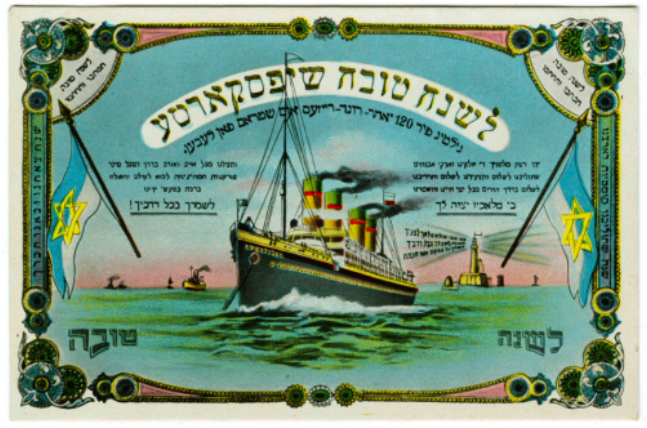 As in the previous card, the Yiddish in bold print across the top of this immigration-oriented Rosh Hashanah greeting card reads: “A New Year’s Ship’s [Passenger] Card”; and just below that, in smaller print, the Yiddish reads: “Valid for 120 years of round-trips on the stream of life.” (Courtesy of www.tumblr.com, accessed 9-25-16.) The Jewish New Year greeting cards printed during the 1920s and 1930s continued to showcase additional Zionist-oriented themes – namely, the acquisition of the land and the “Chalutz” (Hebrew for “pioneer”) dream of working the land. Since many of the new “Chalutzim” were ideologically quite secular, the cards of this era do not generally depict “Zion” in a religious or spiritual light. Rather, in the guise of a socio-political Jewish homeland. These new cards were a reflection on the increasing immigration of Jews to Palestine from the mid-1920s to the mid-1930s, primarily from Eastern and Central Europe. The leading causes of this particular wave of Jewish immigration were the persecution of Jews in Nazi Germany, as well as the anti-Jewish economic legislation in Poland, coupled with the United States’ highly restrictive immigration quotas. Since the establishment of the State of Israel in 1948, numerous types of Rosh Hashanah greeting cards have been printed there, predominantly in Hebrew. The custom of sending cards continued to flourish in Israel – just as it did in the United States – until the advent and use of the internet became increasingly widespread in the 1990s. Nowadays (c. 2016), the trend appears to be aimed progressively toward phone calls and internet messages, with the occasional handwritten cards to certain friends and relatives. Sadly, the art of the handwritten Jewish New Year greeting card has gone the way of card and letter-writing in general. It has become a bit of a lost and cherished art, which I would greatly like to see revived, and perhaps even resurrected. 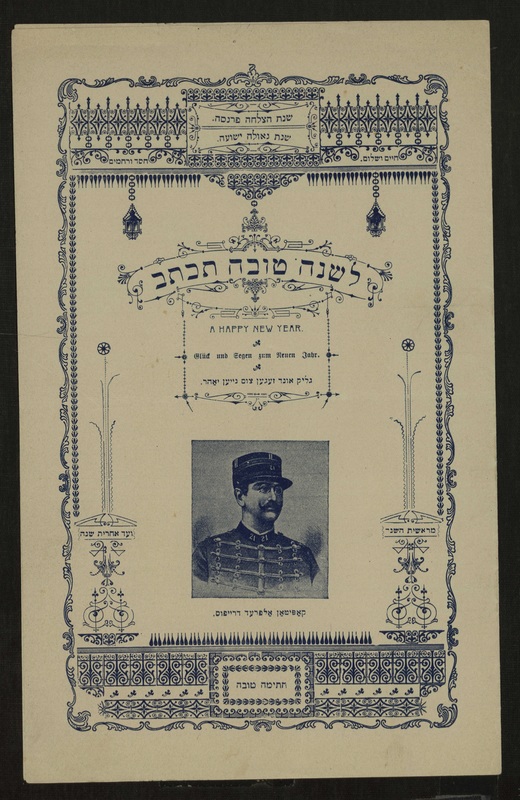 In this unusual Jewish New Year greeting card, which depicts the tragic historic figure of Captain Alfred Dreyfus of the French Army, we see the use of four languages: Hebrew, English, German, and Yiddish. Perhaps ironically, French does not appear at all in this text. Both the German and Yiddish that appear above the image of Dreyfus read: “Fortune and blessing for the New Year.” The caption below Dreyfus’ image reads simply (in Yiddish): “Captain Alfred Dreyfus.” Since the “Dreyfus Affair” spanned the years 1894-1906, it is probable that this card appeared during that same period. (Courtesy of the National Library of Israel: http://web.nli.org.il, accessed 9-30-16.)  This personalized Rosh Hashanah greeting card depicts Jewish refugees/Holocaust survivors, presumably taken in or near one of the Displaced Persons camps in 1947. The Yiddish inscription at the bottom reads: “The most heartfelt wishes for the new year.” (Courtesy of Yad Vashem: www.yadvashem.org, accessed 9-25-16.) Seeing as this is a time both for reflection, as well as for new beginnings, I would like to conclude by thanking all of you who regularly read my blog posts. And for those of you who are new to my blog, I invite you to please sign up to receive my future postings – if you have not already done so – and to share these articles with your friends and relatives. This may be done on the Home page of my website: www.rivkasyiddish.com. I also welcome comments about other Yiddish language Rosh Hashanah cards, as I was only able to include a limited number of these examples in my blog.
Please feel free to contact me at: rivka@rivkasyiddish.com, should you have any Yiddish language Jewish New Year greeting cards, or any other materials that you would like translated. With the recent loss of some of Yiddish theater’s last surviving remnants, I decided that this would be the right time to write about the impact of the Yiddish theater even up until the present (c. 2016). When I speak about this recent loss, I have in mind namely the late Fyvush Finkel (1922-2016), whom I saw perform live at a summer festival only a few years ago in New York City. The relentless performer who began acting on the Yiddish stage in his native New York at the age of 9, ultimately transitioned to the world of American television by the 1990s. He just died at the age of 93 on 14 August 2016.  Fyvush Finkel (1922-2016) in his youth in a theatrical pose. (Courtesy of TheaterMania.com, accessed 8-26-16). Fyvush Finkel (1922-2016) in his youth in a theatrical pose. (Courtesy of TheaterMania.com, accessed 8-26-16). The other name that comes to mind is that of Nina (née Szulman) Rogow (1922-2016) whom I knew personally, as she was a regular and devoted volunteer at the YIVO Institute for Jewish Research’s Archives Department, where I worked for several years. Like Fyvush Finkel, Mrs. Rogow was born in 1922. I was sad to learn of her passing in early July. She, too, was a performer in the Yiddish theater, albeit, in Europe. As a native of Minsk and a fluent speaker of Yiddish, she performed with the Belarus State Yiddish Theater in Novosibirsk. After World War II, she and her husband, Yiddish actor, David Rogow (1915-2007), left the Soviet Union and went on to perform in the displaced persons camps of Germany, touring with the Munich Yiddish Theater. Also an actor in Yiddish theater, although most widely recognized for his role as Mr. Spock in the original “Star Trek” television series (1966-1969), was Leonard Nimoy (1931-2015). He passed away in February of 2015. Unlike Fyvush Finkel, who made his acting debut in Yiddish theater, Mr. Nimoy came to Yiddish-speaking roles already as an adult actor living in Los Angeles. Having grown up with Yiddish at home in his native Boston, Nimoy often played juvenile roles when Yiddish theater troupes would visit the West Coast. In that guise, he had the opportunity to perform alongside some of Yiddish theater’s leading stars, including Chaim Tauber (1901-1972) and Maurice Schwartz (1889-1960). According to his own admission, Nimoy always retained a tender place in his heart for the Mame loshn (“mother tongue” – i.e., Yiddish), and as such, was an ardent supporter of the National Yiddish Book Center in Amherst, Massachusetts. This brings me to a more upbeat, but related topic and one of the major highlights of my summer. After much ado, I had the opportunity to attend the award-winning Yiddish theater performance, “Di goldene kale” – perhaps better known as “The Golden Bride” – staged by the National Yiddish Theatre Folksbiene in New York City from 4 July-28 August 2016. Although the actual performance was conducted entirely in Yiddish (short of a few words here and there in English or in Russian), there were simultaneous supertitles throughout the 2+ hour-long play to help clarify the Yiddish to the mostly non-Yiddish speaking audience. For those in the audience who could follow the nuances of the Yiddish humor, though, this play was all-the-more a splendid treat. A bit more background about “Di goldene kale” / “The Golden Bride”: The music to the operetta or musical comedy was written by Joseph Rumshinsky (1881-1956), considered one of the leading powerhouses of the American Yiddish theater scene of his day, while the lyrics and a libretto were written respectively, by Louis Gilrod (1879-1930) and Frieda Freiman (1892-1962) in the name of her husband, playwright Louis Freiman (1891-1967). The play debuted at David Kessler’s Second Avenue Theatre, in the Jewish Broadway district, on 9 February 1923. According to the English language Forward, it ran for 18 weeks and filled its 2,000 seats before touring the greater United States and international sites, including Buenos Aires, Manchester, England, and Eastern Europe. At the time of its run, on Saturday, 24 February 1923, the Yiddish language Forverts, whose article bore the heading, “`The Golden Bride’ Has Won a Golden Medal Among All of the Mavens” had the following to say about the play: `The Golden Bride,' which is being played at the Kessler Second Avenue Theater, is so full of music, Rumshinsky’s music, beautiful, heart-felt music, which will long be sung in Jewish homes not only here, in America, but everywhere where there are Jews; so one may rightfully call it a Jewish opera. The content of the musical comedy is very interesting, suspenseful, and also has a lot of jokes and dances. It is enough to mention here that the best singers that the Yiddish stage has are now playing at the Second Avenue Theater … See `The Golden Bride' and enjoy a beautiful performance.  Aforementioned article from the Forverts, Saturday, 24 February 1923 (p. 12) entitled, “`The Golden Bride’ Has Won a Golden Medal Among All of the Mavens.” (Digitized article courtesy of Jewish Historical Press, accessed 8-26-16). Aforementioned article from the Forverts, Saturday, 24 February 1923 (p. 12) entitled, “`The Golden Bride’ Has Won a Golden Medal Among All of the Mavens.” (Digitized article courtesy of Jewish Historical Press, accessed 8-26-16). Little did this newspaper article’s columnist realize it back in 1923, but nearly a century later, when “The Golden Bride” would play at the Museum of Jewish Heritage in New York City during the summer of 2016, the wildly applauding audience would be comprised of far more than only Yiddish speaking Jews. In between its debut and contemporary-day performances, the only other time the play was staged was in 1948. Unfortunately, from that point forward until now, it did not see the light of day. Its revival was greatly due to the efforts of musicologist Michael Ochs, who rediscovered the play’s libretto and lyrics and reconstructed the entire work. Also aiding him in this process were the late Chana Mlotek (1922-2013), my former colleague at the YIVO Institute, and her son, Zalmen Mlotek, artistic director of the Folksbiene. I will not give away the entire plot of the play, should any of my readers have the opportunity to see it at some point in the future (I, for one, hope that it returns to the stage again soon, and that it is performed nationally – if not internationally). But suffice it to say that it is part opera – replete with visually stunning scenery and costumes; melodrama in the “schmaltz” style of the early 20th century; and romantic comedy – part socio-economic commentary. The plot itself opens in a quintessential unnamed shtetl in the land of “Mother Russia,” and ultimately winds its way westward to New York City, America – the land of “Uncle Sam.” The story centers on the fate of protagonist Goldele – Yiddish for “Goldie” – from which the play evidently draws its title. Goldele is a lovely orphan who hails from an impoverished background, but falls into the proverbial shmaltsgrub (i.e., Yiddish for “pit of chicken fat,” but loosely translated to connote, “strike it rich”), when she suddenly receives a large family inheritance. This unexpected windfall prompts Goldele to set out to claim her inheritance in America, while also seeking out her long lost mother, and finding a worthy suitor in the process. Given its high success rate both in 1923 and in 2016 – 93 years later! – as a recipient of the New York Times and New Yorker Critic’s Pick and a two time Drama Desk Award nominee – it is hard to imagine that Joseph Rumshinsky initially feared that his operetta might turn out to be an utter disaster. According to his autobiography, Klangen fun mayn lebn (i.e., Yiddish for “Sounds from/of my life”) (1944), during the rehearsals for “The Golden Bride,” nearly the entire acting company was unhappy with the play.  Front cover of Joseph Rumshinsky’s "Klangen fun mayn lebn" (“Sounds from/of my life”) (1944). (Courtesy of the National Yiddish Book Center, accessed 8-26-16.) Front cover of Joseph Rumshinsky’s "Klangen fun mayn lebn" (“Sounds from/of my life”) (1944). (Courtesy of the National Yiddish Book Center, accessed 8-26-16.) Rumshinsky even states on page 673 of his book that “I was desperate and afraid of a huge failure (when then am I not afraid?...).” Yet, he was ultimately thrilled by its overwhelmingly positive reception (as seen in the following): And when `The Golden Bride' came before the court, before the judge and the jury, who had to give their verdict, I mean the esteemed audience, which has to decide whether the performance should continue to exist, or should limp along for a few weeks – in the case of `The Golden Bride,' the court, I mean the audience, immediately on the first night gave its verdict, that it is a huge success. The laughter and the applause, and especially the packed houses, lasted for 18 weeks. But perhaps the greatest litmus test for the play’s popularity and high success rate was the fact that the performance was visited one night in 1923 by two of the music and theater world’s leading figures of the day: composer and songwriter Irving Berlin (1888-1989) and theater and film director Max Reinhardt (1873-1943). On this subject Rumshinsky modestly takes little credit for the production’s triumph, remarking that “… the happiest person that night was the unknown playwright and provincial actor Louis Freiman, whose operetta `The Golden Bride’ was seen by two such major personalities the likes of Irving Berlin and Max Reinhardt” (p. 674). My great hope for the future of Yiddish theater – especially after having read the biographical profiles of the multi-talented personalities mentioned here and having attended the recent production of “Di goldene kale” / “The Golden Bride” – is that it will continue to flourish and proliferate throughout the world. I would like to see more generations of young Yiddish theater enthusiasts exposed to this once widespread form of entertainment – regardless of whether or not they are Jewish or fluent in the Mame loshn. On the other hand, if Yiddish theater should serve as the conduit for the Yiddish language and its associated culture and literature, I am certainly a strong proponent of that. What’s more, I would love to see a revival of other long-since-forgotten plays once featured on the Yiddish stage. Ideally, though, we will not need to wait another long 93 years for the next such Yiddish theater revival.
If you have any materials pertaining to the Yiddish theater – or otherwise, for that matter – that you would like translated, please feel free to contact me at: rivka@rivkasyiddish.com.  The severed headstone of Yerachmiel Yosef Pszenica before it was restored. The simple text reads in Hebrew: “Here is buried Reb [an honorific term meaning “Mr.” or “Sir”] Yerachmiel Yosef, son of Reb Boruch Zev, died 6 Tammuz 5701” (Wirtualny Cmentarz, accessed 7-14-16). The severed headstone of Yerachmiel Yosef Pszenica before it was restored. The simple text reads in Hebrew: “Here is buried Reb [an honorific term meaning “Mr.” or “Sir”] Yerachmiel Yosef, son of Reb Boruch Zev, died 6 Tammuz 5701” (Wirtualny Cmentarz, accessed 7-14-16). Since I began writing this blog over a year ago, I have definitely seen an increase in the number of readers interested in genealogical matters. For that reason, I have decided to share some of my recent forays into my own family history or genealogy. More specifically, I want to share with you my own experience in Poland nearly two years ago, in September-October 2014, to locate information about my maternal grandparents and their families. I was motivated to write about this particular subject now, after revisiting mementos from the aforementioned trip, and realizing that one of the documents I scanned – a brief, but poignant letter – had been written by hand exactly 71 years ago to the day by my maternal grandmother, in the painful aftermath of World War II and the Holocaust. The coincidental or “bashert” (Yiddish for “destined” or “predestined”) nature of this encounter, especially, prompted me to share my own personal genealogical journey with you in the form of the following blog. Respectively speaking, my maternal grandmother, Tola Pszenica Pinkus (b. 1921-d. 1999) was born and came of age in Warsaw, and my maternal grandfather, Shloime Pinkus (originally Pinkusiewicz) (b. 1904/1905-d. 1998) grew up and was busy raising a family of his own, in pre-World War II Kielce. (This was the city about which I wrote in my blog from this past May.) My grandfather’s mother and my namesake, was named Rywka Gorlicka Pinkusiewicz (b. 1870s-d. 1915/1916), and she, in turn, hailed from the town of Chmielnik, which neighbors on Kielce. (Chmielnik was the town about which I wrote in my blog of a year ago.) The main reason for my journeying to Poland in 2014, my third excursion there since 2002, was the fact that I had uncovered some rather moving information since my last visit there, roughly a decade earlier. This new information that I stumbled upon in c. 2012 came by way of the following incredibly helpful website and database, Wirtualny Cmentarz (Polish for “Virtual Cemetery”), operated by the Foundation for Documentation of Jewish Cemeteries in Poland: The Database of the Jewish Cemeteries in Poland. It was there that I located an entry for my grandmother’s paternal grandfather, Yerachmiel Yosef (also known simply as “Josek” or “Yossel”) Pszenica (b. 1866-d. 1941), who died in the Warsaw Ghetto on the 6th day of Tammuz 5701, or 1 July 1941. Moreover, the headstone – entirely severed from its foundation – included the name of his father, Boruch Zev, which I knew from my late grandmother to have been a prevalent compound name in the Pszenica family. Indeed, my grandmother had both a brother and a paternal uncle who bore these very same names. In addition, I also knew from an earlier visit to Warsaw’s Żydowski Instytut Historyczny (ŻIH), or “Jewish Historical Institute,” that this date of death sounded correct. For at ŻIH I had managed – much to my great amazement – to uncover a death certificate, also from the Warsaw Ghetto, in 1941, issued for my great great grandfather, and signed off on by a Dr. M. Finkelkraut. In light of all these combined pieces of information – coupled with the fact that “Pszenica” (pronounced “Pshe-nee-tsa”) – Polish for “wheat” – is not a common surname, I knew that I had the correct person. What genuinely moved me upon seeing this headstone entry and accompanying photo, was the fact that great great grandfather Pszenica – whom my grandmother had referred to endearingly as “Zayde Yossel,” while she was growing up – had somehow merited having a marked individual grave in a place and time when poverty, disease, starvation, and death were all horribly rampant. Tragically, during the ghetto period, it was more common for the dead to lay in the streets for days before simply being carted off and buried in a mass grave. Clearly, it must have taken the family all of its wherewithal to scrounge up the money to have even this simple headstone carved and engraved as a sign of everlasting honor and devotion to the patriarch of their family. My biggest regret in making this discovery was that neither my grandmother, nor her younger sister, Lola Pszenica Jacobson (b. 1925-d. 2008) was alive to witness what I had found. What’s more, my grandmother had herself most likely never ever seen the headstone, as she had escaped from the Warsaw Ghetto – quite possibly, shortly before her grandfather’s death, also in 1941. Furthermore, she never returned to Warsaw for more than a few days, in the immediate aftermath of the war, for the sole purpose of searching for other possible surviving family members – a search that my grandmother had told me proved to be both utterly heartbreaking, as well as futile. My great aunt Lola, I suspect, must have been present at her grandfather’s burial, as she remained hidden in a bunker beneath the streets of the Warsaw Ghetto throughout the ghetto’s final days (the Warsaw Ghetto uprising – known in Yiddish as “Der Varshever geto oyfshtand”). But she, too, had died too soon for me to share this discovery with her. Sometime after learning of the existence of the headstone and the fact that it was in such a sorry state, as illustrated by the above photo I found on the Wirtualny Cmentarz site, I knew that it was essential that my family have the headstone restored. It was our duty and obligation to see to it that the grave be maintained and cared for, even in our absence. Thus, I arranged with the cemetery caretaker, Przemysław Isroel Szpilman (a relative of Władysław Szpilman, the pianist in the book and film, “The Pianist”) that this take place, which it did, not too long before my visit to Poland. My desire was then to go visit the grave in-person, to see how it appeared in its newly restored state, and to serve as an emissary on the part of other family members who would not be making this trip with me. On some level, I think I wanted to do this most of all, for my grandmother and great aunt, neither of whom was herself any longer among the living. I knew that they would have wanted somebody to see to this, had they still been alive at the time.  Recently restored headstone and burial site of my great great grandfather, Yerachmiel Yosef Pszenica, son of Boruch Zev (d. 6 Tammuz 5701 or 1 July 1941, Warsaw ghetto). (Photograph taken by Rivka Schiller, Warsaw Jewish Cemetery on ul. Okopowa, September 2014.) Recently restored headstone and burial site of my great great grandfather, Yerachmiel Yosef Pszenica, son of Boruch Zev (d. 6 Tammuz 5701 or 1 July 1941, Warsaw ghetto). (Photograph taken by Rivka Schiller, Warsaw Jewish Cemetery on ul. Okopowa, September 2014.) My very first day in Warsaw – I was scarcely off the plane and was terribly jetlagged – one of my friends in Warsaw dropped me off at the Warsaw Jewish Cemetery on ul. Okopowa (Okopowa St.), where I searched for hours in vain for the grave, which I knew from my correspondence with Mr. Szpilman, must be located in some far-flung corner of the cemetery. After two more attempts of searching and hiking through the forest and jungle of the cemetery, on my third visit there, I was fortunate to intercept Mr. Szpilman, who ultimately showed me where the newly restored headstone was. I was adamant that after coming this great distance, there was no way that I was going to leave Poland without actually seeing the grave of my great great grandfather. It is worth noting here that the Warsaw Jewish Cemetery is one of the most vast, sprawling, and overcrowded Jewish cemeteries in the world. As one friend aptly described it to me, it is an entire city, a necropolis, unto itself. Even well before World War II, it was overcrowded. Amazingly, the cemetery managed to survive the widespread destruction wreaked on Warsaw during the Second World War. Indeed, according to Norman Davies in his thorough work, Rising '44: The Battle for Warsaw, 98 percent of Warsaw’s pre-war buildings were destroyed during World War II, particularly, during the Warsaw uprising of 1944. Suffice it to say that this is a small burial site, well concealed within the depths of the overgrown cemetery, not too far from the towering brick wall at the back side of the cemetery. Needless to say, this is not the part of the cemetery that average visitors are ever likely to see. Most visitors will barely venture beyond the more pristine entrance area in which one finds the monument to Janusz Korczak (pen name of Henryk Goldszmit, b. 1878/1870-d. 1942), the martyred Polish-Jewish educator, children’s author, pediatrician, and orphanage director who, rather than choosing the freedom offered him and thereby abandoning his flock of orphans in their greatest hour of need, instead chose to accompany them when they were deported to the Treblinka extermination camp. By this very act, Korczak perhaps knowingly signed his own death warrant. The tidier and less crowded front rows of graves likewise include the shared burial ground of three noteworthy Yiddish writers: Y. L. Peretz (b. 1852-d. 1915), Sh. An-ski (b. 1863-d. 1920), and Yankev Dinezon (1856?-1919). Also in this part of the cemetery is the oft-visited grave of Esther Rokhl Kamińska (b. 1870-d. 1925), the mother of Yiddish theater, as well as of many other noteworthy literary, theatrical, political, and scholarly figures. Having finally found my great great grandfather’s burial site – the main impetus behind this journey – I knew that I also wanted to spend some time at ŻIH, which I had previously visited on my earlier trips to Poland, to see what more I could uncover about my grandmother and her family. What I found there included death certificates – all seriously singed from fires that blazed in the Warsaw Ghetto, especially during the Warsaw Ghetto uprising of 1943, at which time the German Forces, commandeered by SS-Gruppenführer Jürgen Stroop, blew up the Great Synagogue of Warsaw on Tłomackie Street. It is worth mentioning that the Great Synagogue stood next door to the ŻIH building, which remarkably, was not burnt down during the liquidation of the ghetto. It is for that reason alone that I was able to access these family documents these seven decades later. 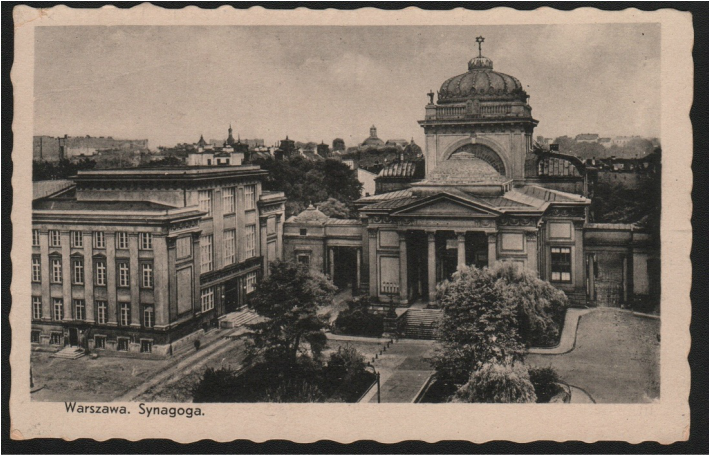 Pre-World War II postcard depicting the magnificent Great Synagogue on Tłomackie Street (completed in 1878), which neighbored on the Żydowski Instytut Historyczny (ŻIH), to the left. The synagogue was dynamited by SS-Gruppenführer Jürgen Stroop at the close of the Warsaw Ghetto uprising, on 16 May 1943. (Courtesy of the Jewish Historical Institute, accessed 7-15-16.) 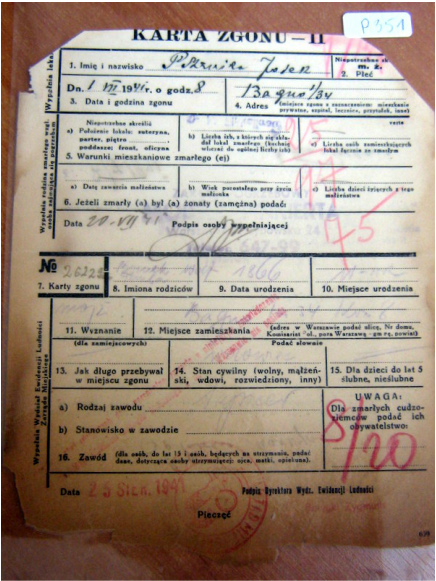 Death certificate of Josek Pszenica (i.e., Yerachmiel Yosef Pszenica), who died on 1 July 1941 at 8:00 o’clock in Warsaw, Poland and was born in April of 1866 in the same city, making him 75 years old at the time of his death. (Photograph taken by Rivka Schiller, fall 2014; courtesy of the Żydowski Instytut Historyczny (ŻIH), Warsaw, Poland.) Death certificate of Josek Pszenica (i.e., Yerachmiel Yosef Pszenica), who died on 1 July 1941 at 8:00 o’clock in Warsaw, Poland and was born in April of 1866 in the same city, making him 75 years old at the time of his death. (Photograph taken by Rivka Schiller, fall 2014; courtesy of the Żydowski Instytut Historyczny (ŻIH), Warsaw, Poland.) The death certificates were from one of my grandmother’s paternal great aunts, “Raizel Pszenica,” a maternal first cousin named “Moishe Pinkiel,” and from her paternal grandfather, the one about whom I have written here: “Yerachmiel Yosef Pszenica.” The secular date of death on the death certificate: 1 July 1941 was the matching equivalent of the Jewish date of death found on the headstone in the Warsaw Jewish Cemetery: 6 Tammuz 5701, so there was absolutely no question that all of my puzzle pieces concerning Yerachmiel Yosef Pszenica were falling right into place. In addition, I found different registration cards for both my grandmother and her sister, Lola. In the wake of World War II, Poland was still in a state of general chaos, and Jewish survivors were anxious to locate possible surviving relatives. As a result, the Central Committee of Polish Jews (CKŻP), the main and essential political and social organization of the Polish Jewish community at that time, established a network of offices in various parts of the country to assist the returning survivors in locating family and with their most basic needs. 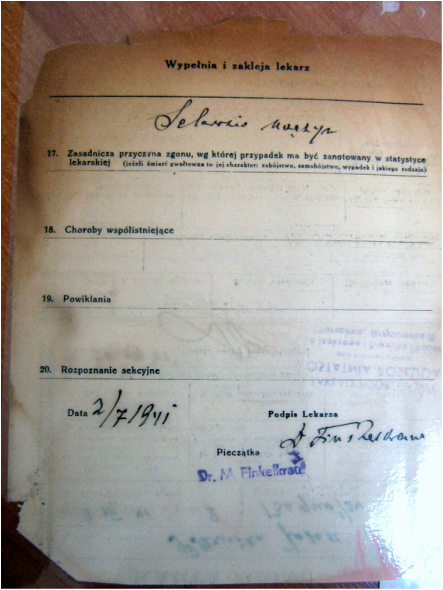 Death certificate of Josek Pszenica (i.e., Yerachmiel Yosef Pszenica), verso, signed by Dr. M. Finkelkraut on 2 July 1941. (Photograph taken by Rivka Schiller, fall 2014; courtesy of the Żydowski Instytut Historyczny (ŻIH), Warsaw, Poland.) Death certificate of Josek Pszenica (i.e., Yerachmiel Yosef Pszenica), verso, signed by Dr. M. Finkelkraut on 2 July 1941. (Photograph taken by Rivka Schiller, fall 2014; courtesy of the Żydowski Instytut Historyczny (ŻIH), Warsaw, Poland.) Among these offices was one in Praga, a neighborhood just beyond Warsaw, east of the Vistula River. According to my grandmother and great aunt, most of Warsaw’s infrastructure was so bombed-out and covered in rubble at that time, that the “Jewish Committee” was simply unable to set up shop in Warsaw proper. The following is but one of many images depicting how utter and widespread Warsaw’s destruction was by the close of World War II, at the time when my grandmother and great aunt returned there to search for living relatives. As I recall my grandmother relating to me, when she and my great aunt returned to what had formerly been their home prior to World War II, a large and regal-looking building at ul. Śliska 34, they found nothing more than a pathetic-looking single wall left standing. The rest of the building had been leveled during the bombings of and street combat fought during the war. As for former building residents, the two Pszenica sisters were unable to find any additional surviving members of their immediate family. The only person whom they encountered was the building’s superintendent, who informed them that no other members of their family had returned, aside from the two of them. While searching yet further in their neighborhood for any sign of surviving family members, my grandmother met a Polish clerk, somebody who had obviously known her father before the war. The clerk remarked to my grandmother what a shame it was that “Pan Pszenica” [“Pan” being a Polish title of honor, something akin to “Mr.” or “Sir”] had not survived, as the greater Warsaw community was now in dire need of his erudite knowledge and multilingual skills in rebuilding their infrastructure. It was only at that time – after her father had already been dead for several years – having died of starvation in the Warsaw Ghetto – that my grandmother ultimately learned of her father’s widely recognized excellent reputation and linguistic skills. According to my grandmother, her father, Towia Gitman Pszenica, was fluent in seven languages.  View of ul. Śliska today (c. 2016), most of which was rebuilt in the wake of World War II. The large cream-colored building in the forefront bears the address: ul. Śliska 51 and was formerly the Bersohn and Bauman Children’s Hospital, which both my grandmother and great aunt recalled from their prewar childhoods. The structure was erected thanks to funding from two wealthy, philanthropic Jewish families in the late 1870s to treat Warsaw’s Jewish children. The building somehow withstood the Second World War and today houses the Children of Warsaw Hospital. (Courtesy of Robert Gujski's "In Art" Gallery - Warsaw, accessed 7-16-16.) One of my grandmother’s registration cards, which I have included here, attests to the fact that she was incarcerated in Auschwitz and Starachowice, a labor camp. It also provides the tattooed identification number issued to her by the Germans in Auschwitz-Birkenau: A-14229. This was the number that I was accustomed to seeing on the arm of my grandmother from the time I was a little girl, and which I later found – some years after her death – in the book, Żydzi Polscy w KL Auschwitz Wykazy Imienne / Polish Jews in KL Auschwitz Name Lists (2004), published by none other than ŻIH. Additionally, the registration card mentions the names of my grandmother’s parents: Towia (Gitman) and Miriam Pinkiel Pszenica, as well as the address at which she lived in Warsaw at the outbreak of World War II: ul. Śliska 34. All of these details were merely further confirmation of information I had learned years before, directly from my grandmother herself. But of all the documents I unearthed at ŻIH, perhaps the most emotionally stirring one of them all was that of the short letter my grandmother composed by hand in pencil in what, as I have been informed by native Polish speakers, is a very nice and grammatically correct Polish. This letter, which is quite well preserved – but also rather faint and difficult to make out today on account of the pencil used and the acidification of the paper – was written exactly 71 years ago to the day on which I am composing these very lines: 14 July 1945. 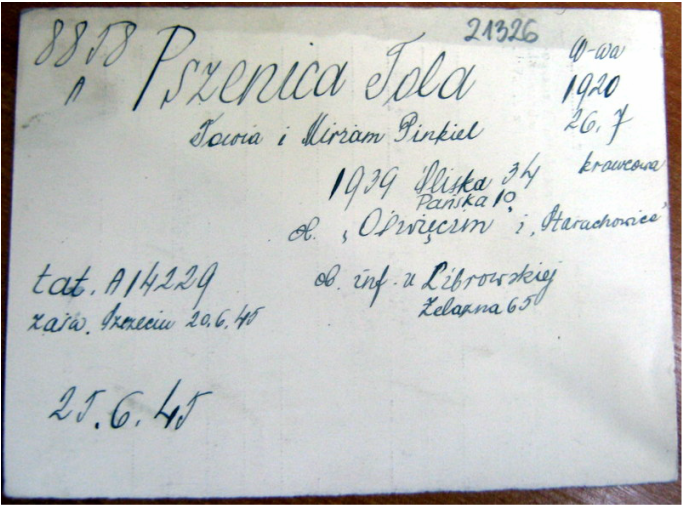 Registration card of Tola Pszenica filled out on 25 June 1945 under the auspices of the Central Committee of Polish Jews in the vicinity of Warsaw, shortly after the end of World War II. Among the various information provided here are the names of some of the concentration and labor camps in which my grandmother was incarcerated (i.e., Auschwitz, Starachowice); the number she had tattooed on her arm at Auschwitz-Birkenau (A-14229); that she was the daughter of Towia (Gitman) and Miriam Pinkiel Pszenica and had resided in Warsaw at ul. Śliska 34 in 1939, prior to the outbreak of World War II; that she was born on 26 July 1920 (incorrect; she was actually born in 1921); and that she had training as a seamstress. (Photograph taken by Rivka Schiller, fall 2014; courtesy of the Żydowski Instytut Historyczny (ŻIH), Warsaw, Poland.) 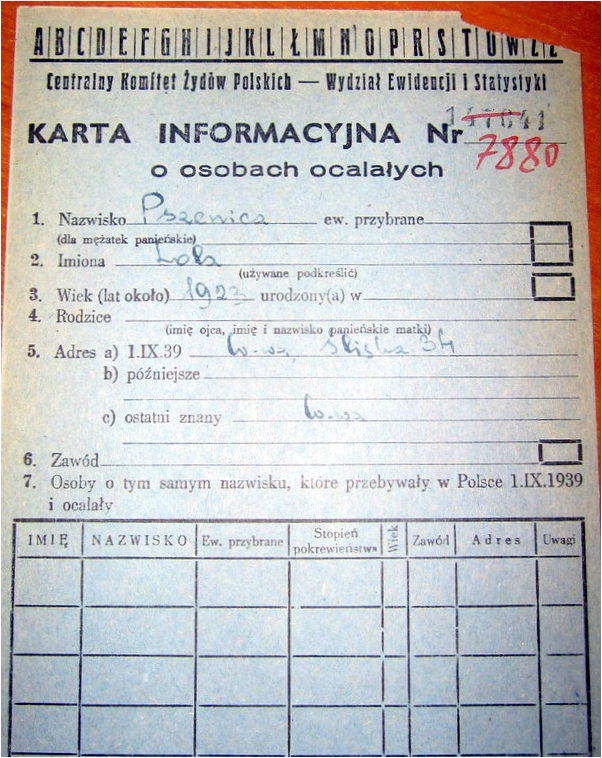 Registration card issued by the Central Jewish Committee of Polish Jews to Lola Pszenica, the younger sister of my grandmother, Tola; and to other survivors of World War II and the Holocaust. The above form states that my great aunt was born in 1923 (incorrect; she was born in 1925) and that she resided in Warsaw at ul. Śliska 34 as of 1 September 1939, the day on which Germany declared war on Poland. (Photograph taken by Rivka Schiller, fall 2014; courtesy of the Żydowski Instytut Historyczny (ŻIH), Warsaw, Poland.) In this letter, which is addressed to the “Jewish Committee,” my grandmother makes a heartfelt plea, stating that she is now looking for some means of work; that she had training as a seamstress (my grandmother was always remarkably talented when it came to crocheting and knitting); that she was in the Auschwitz Concentration Camp; and that, in her own words: “… jestem bez dachu nad głową i bez środków do życia.” (“… I am without a roof over my head and am destitute.”)  Letter written in Polish by Tola Pszenica on 14 July 1945 in which she presents her case before the “Jewish Committee,” and requests some sort of job, as she is now destitute and without a roof over her head. She mentions that she received some training as a seamstress and that she was in the Auschwitz Concentration Camp. Shortly after writing this letter, my grandmother was hired to work in the children’s home in Otwock, overseen by the Jewish Committee, not far from Warsaw. My grandmother worked there for several months until she left Poland for Germany, sometime before the Kielce pogrom of 4 July 1946. (Photograph taken by Rivka Schiller, fall 2014; courtesy of the Żydowski Instytut Historyczny (ŻIH), Warsaw, Poland.) Reading that familiar handwriting of my grandmother, yet in another language in which I do not recall ever seeing her actually compose anything on paper – I could hear the desperation and fear in her words. Yet, at the same time, I could still sense my grandmother’s inner strength, her readiness to take control of a horrible situation, and her preparedness to fend for herself. These were all traits that I knew to be representative of my grandmother, a woman who had an incredibly strong spirit and who somehow managed to elude death numerous times in her life, before tragically succumbing to cancer at the age of 77. I remember the final days leading up to her death, for example, when my grandmother was in extreme physical pain due to the effects of chemotherapy and the cancer that was rapidly metastasizing inside of her. Nonetheless, she somehow got up the physical strength to make her widely popular apple cake – a time consuming and physically arduous job for anyone, let alone for somebody who was now bedridden much of the time. She was determined that she complete this task for my younger brother, David, who was on a brief visit home from Israel, where he was studying at the time. When my brother returned to Israel, he took the entire cake with him in multiple Gladware containers, which he subsequently shared with his friends there. Everyone had heard about his “Bubbe’s” marvelous apple cake. Sadly, that apple cake outlived my grandmother, who died only a couple of days after making the delicacy for her grandson. My brother arrived in Israel right around the time that my grandmother died, making it impossible for him to return home again in enough time for the funeral and burial. As I recall hearing, he continued to hold onto those last pieces of apple cake even after they were far from edible. I think this was his own way of not letting go of my grandmother too quickly. Since my grandmother’s death those 17 years ago, no family member has been able to successfully replicate that apple cake, whose recipe my grandmother had created and knew by heart, but never recorded on paper. Believe me, we all have tried multiple times. Baking an apple cake for one’s grandson may seem an ordinary task to some. But to those of us who watched her and knew the struggle she was fighting inside her body, it was like the Battle of Waterloo. My grandmother knew she was nearing the end of her life; she could have resigned herself to this. But for her, every second was important, and there were no excuses. As I recall my grandmother relating to me, it was likely not long after she wrote the letter to the Jewish Committee that she was asked to interview for a job working at the children’s home in Otwock, a short distance from Warsaw. The orphanage – like other Jewish-run organizations and institutions that existed in Poland in the wake of World War II – was overseen by the Central Committee of Polish Jews. (I wrote about the orphanage and one of its particular orphans, Walter Saltzberg, in the Forward in August 2011.) But because my grandmother was still quite swollen and ill in the aftermath of the war, due to starvation and wartime injuries, she was unable to go in-person herself to interview for the position. Instead, she sent my great aunt, her sister Lola, in her stead. If I understood correctly, my great aunt actually posed as my grandmother and got my grandmother the job at the orphanage. This kind of stunt would be difficult for most of us to pull off even in good health, but my grandmother knew it was her only chance at survival. Although she did not work there for more than several months, at the most – as I know that she had already left Poland for Germany by the time of the infamous Kielce pogrom of 4 July 1946 – she still had memories of those children years later. According to her, a number of those children had been incarcerated with her in the camps during the war. These were the major tasks that I had set out for myself to accomplish in Warsaw – to find great great grandfather Pszenica’s grave and any documentation about my grandmother’s family. Obviously, I could not resurrect my grandmother, great aunt, or all the ghosts of their murdered family members through achieving these tasks. Nevertheless, I felt that at the very least – and perhaps, in fact, at the very most – I had helped to memorialize these individuals – to give some lasting identity to those who have virtually nothing tangible today to attest to their sheer existence. After all, at the end of the day what is it that truly remains of a person, but the memories, the deeds, and the name of that person?
The aforementioned account of my search for information about my maternal family in Poland, which both began and ended in Warsaw, is but a part of the genealogical journey I made in the fall of 2014. The remainder of that two-week long trip also included excursions to Kielce and Chmielnik, where I explored the respective city and town of my maternal grandfather and great grandmother; Kraków; Majdanek, where my great aunt Lola was incarcerated following the destruction of the Warsaw Ghetto and her subsequent round-up at Umschlagplatz in May 1943; and Treblinka, where much of my family and Polish Jewry, as a whole, was brutally murdered. However, given the space constraints of this blog, I will conclude here and leave the rest for a future blog. Trekking back to Poland and following the threads of my grandmother’s story was both difficult and moving for me. But, it was also comforting. I take solace in the fact that, in this small way, I am telling the story that my grandmother and her family can no longer tell themselves… and that, through this, their legacy lives on. If you have any old or newly uncovered documents pertaining to your own family history that you would like translated, please feel free to contact me at: rivka@rivkasyiddish.com. I have to admit that much of the material that I encounter as a translator of Yiddish is of a somber and foreboding tone. A great deal of what I read and translate is comprised of family letters, whether between two towns in Europe or two international sites, typically separated by a vast ocean. Many of these handwritten texts are from the years leading up to the Holocaust, and it is understood that at least some of the individuals involved in the letter exchange did not survive the Second World War and the Holocaust. As such, there is often a dark cloud overshadowing the work that I do – as valuable and important as I know it is – both for my clients and for me. For this reason, I would like to highlight in the following blog, one particular noteworthy instance in which I was privy to a series of beautiful and memorable love letters – all written in a very readable Yiddish, approximately a century ago, beginning in 1918. What’s more, the love affair that transpired over the course of this romantic exchange was set entirely in the New World of New York City. This is the type of story, which I hope will have special appeal to all of my readers who have roots, or who presently reside, in NYC, and/or whose ancestors immigrated to this country in the early 20th Century. Indeed, it is so rare that I come across writing of this nature in my Yiddish repertoire, that although the following account of my translation work dates back several years – to 2009 – the experience of reading such romantic innocence has remained with me up until the present day. Moreover, it prompted me to renew my contact with my former client, Anita Abrams. It was she who hired me to translate the letters written by her grandfather, Harry Zapol (1896/1897-1963), to her grandmother, Zelda “Jennie” Chernin (1898/1899-1973). As Anita conveyed to me recently, she grew up quite close to her grandparents, as they lived together under one roof for many years, and because her mother, May (1920-2012) – their daughter – was an only child. As such, she was able to offer the following biographical details about “Harry” and “Jennie,” which help provide historical context for the unfolding story of their courtship and Yiddish love letter correspondence. Jennie Chernin (originally, “Zelda”) was born in June 1898 or 1899 in Vitebsk, Russia, the city often associated today with the painter, Marc Chagall (1887-1985). She immigrated to the United States in 1909, along with her parents and seven other siblings. The family resided at 161 Madison Street in New York City’s Lower East Side neighborhood. Harry Zapol, born in Minsk, Russia, in June 1896 or 1897, immigrated to the United States in 1912, where he already had a sister and an uncle. He initially lived in a boarding house at 73 East 105th Street in New York City’s East Harlem neighborhood. His first job in America was as a clerk; later, he worked as a taxi driver. According to Anita, she believes her grandparents met sometime in 1916, having been introduced to one another by a “girl” (Harry’s own words in one of his letters to Jennie) who lived in the same boarding house as he did. As Harry romantically pursued Jennie, he became jealous of her would-be “suitors” – other young men who would visit her at her parents’ home. Fearful of his growing competition, Harry asked Jennie’s mother for permission to marry her daughter, and she agreed. The two had a civil marriage on March 24, 1919, but did not have a religious Jewish wedding in a synagogue until nearly one year later, on January 3, 1920. During the gap period of March 1919-January 1920, Jennie continued to live at home; she and Harry did not live together officially as man and wife until after they had had their religious marriage ceremony. It goes without saying that this was a far more innocent and traditional era than our own. Anita and I both agreed that one of her grandfather’s letters, in particular, seemed to express his depth of feeling, love, and ardor for her grandmother. This is the correspondence that we assigned the “#3,” as there were several multi-page letters from which to choose. Frankly, I found all of them to be emotionally moving, but due to space constraints, I am unable to showcase their entirety in this blog. In lieu of that, allow me to present here some English translation excerpts from Harry Zapol’s Yiddish love letter “#3” to his future wife, Jennie. [Please note, that this may in fact, be two letters in one, as based on the multiple closing greetings, indicated below.] A few pages of the original letter are also included here for the sake of authenticity and as a source of reference for those of you who read Yiddish. October 22, 1918 Dear and Beloved Jennie, Today is my first day of work and I will tell you the truth – that I don’t feel too bad. I came in in the morning and everyone turned and looked at me gleefully. Naturally, I rejoiced together with all of them, but at the same time, I was thinking to myself that they – [complete] strangers to each other – mere acquaintances, were rejoicing. And so I considered how you, my dear, rejoiced, with the thought that your beloved feels well. Yes, darling, it is very good to have a lover, but imagine how good it is to have the thought in mind that one is loved by the same person who loves you… Hoping that this letter will find you in good humor and that you will read it with joy, I remain your lover. I am sending you kisses XXX, but don’t get them from the letter carrier…. Good night, my dear And finally, the time came… when I had the honor to meet the person for whom I had so long and impatiently waited – for the happy hour – to meet. Oh, how happy I was then! I will never forget that evening. I was sitting there beside you, and I myself couldn’t believe it. But unfortunately, the evening passed too quickly and didn’t even leave me with enough time to gaze at you – how badly I wanted to gaze at you… For my heart told me that after this evening I would not see you [again] for a long time, and that I must record what I had experienced… Sometimes you would raise me up very very high, and afterward, you would cast me down very very low. Sometimes you made me the happiest man, and then suddenly, you would upset me to the point that I didn’t know in which world I was living. And last summer, this very thing came to pass quite often, when I had an appointment to go with you to Richmond Hill [i.e., a neighborhood in Queens, NY], and you agreed to this. Then, I was the happiest man on earth… And so, there are just a few more questions left and I shall finish my letter. One question always comes to mind: “Does Jennie love me?” Please, Jennie… Try to find out if Jennie loves Harry! I will therefore pay very well with… And one more thing – if you love me – I would like to know, in what form would you like this love [expressed] – at home or openly? I will be happy with whatever you agree to, because your request will be holy and dear unto me. And I will fulfill it exactly [as you desire]. And so, I will conclude my writing here, wishing you a good night. From me, yours, XXX Harry In light of Harry’s thoughtful and amorous words, I asked Anita whether she felt that her grandparents had had a good marriage, to which she replied in writing with the following: “I feel they had a good marriage. I really never heard them argue. They had nice friends and went out and always had a lot of company. They were always a `team.’ My grandmother … always taught me that `love and respect go hand in hand.’ … I feel extremely blessed that I had them in my life and had the experience of being totally embraced by them. When they passed away, to say I was heartbroken is an understatement. They will always be a part of my heart. They are always with me. His [i.e., Anita’s grandfather, Harry] love for her totally overwhelmed me. When I went to visit their graves several years ago, instead of each grave having a bed of yews over it (as it was when they were planted), the plants had come together as one, just as my grandparents had been in life.” I can scarcely add to Anita’s own eloquent tribute to her grandparents and the deep affection and adoration they had for one another in this lifetime – and beyond. Suffice it to say that I was thoroughly charmed and captivated by reading the nearly 100-year-old Yiddish love letters of Harry Zapol to the “apple of his eye,” Jennie Chernin. Furthermore, I hope that in the future, I will continue to see more of this type of Yiddish reading material, as it serves as a reminder to us today, of the timelessness of the human spirit and the tenderness of the human soul.
If you have any family letters or other materials that you would like translated, please feel free to contact me at: rivka@rivkasyiddish.com. |


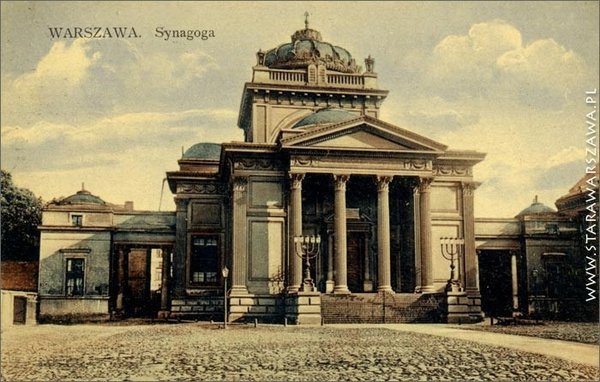
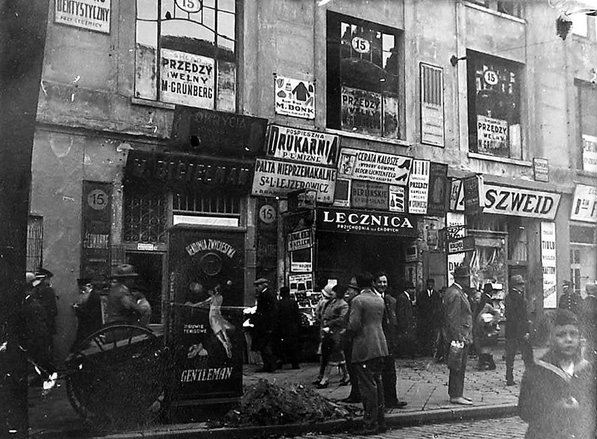

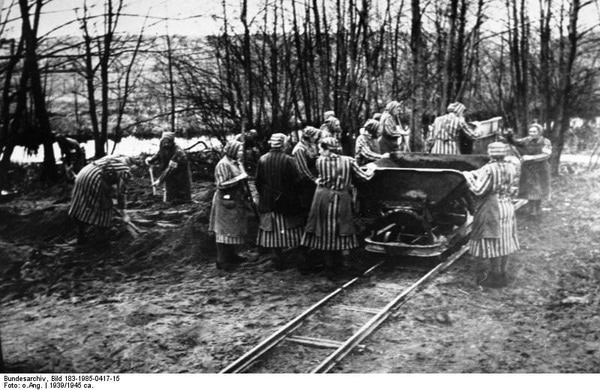
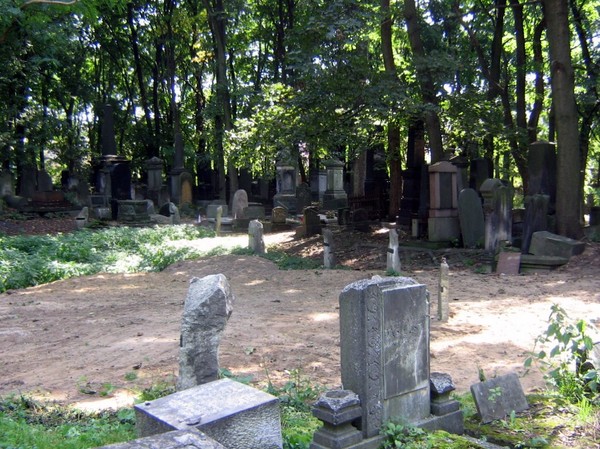

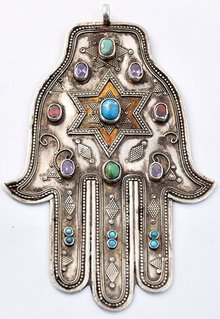


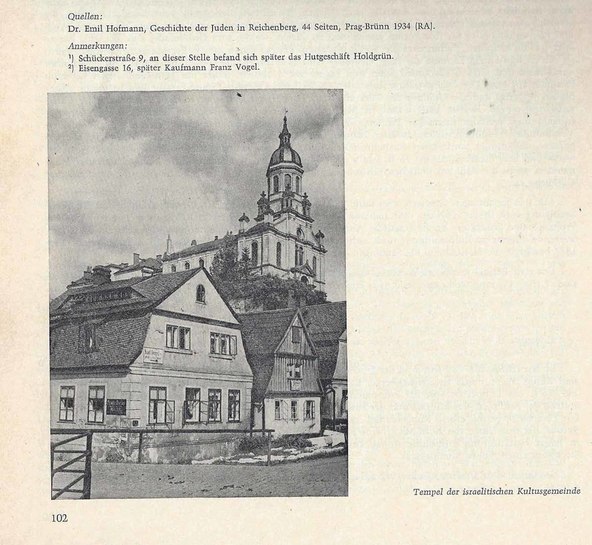












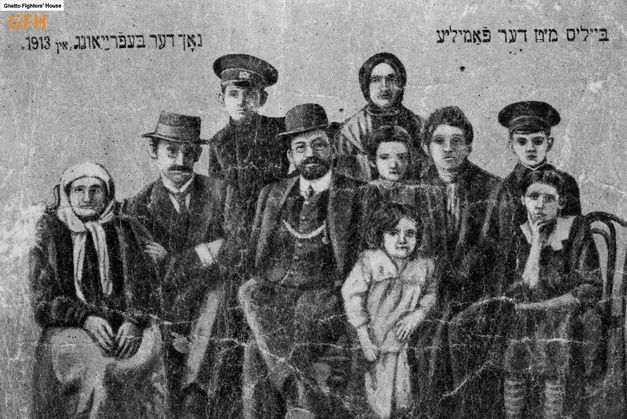


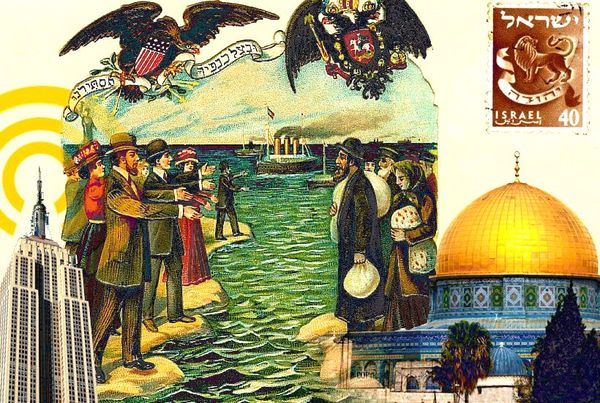




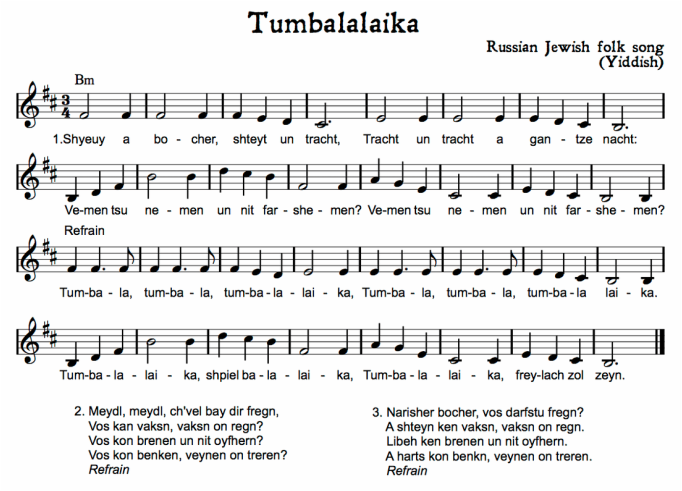

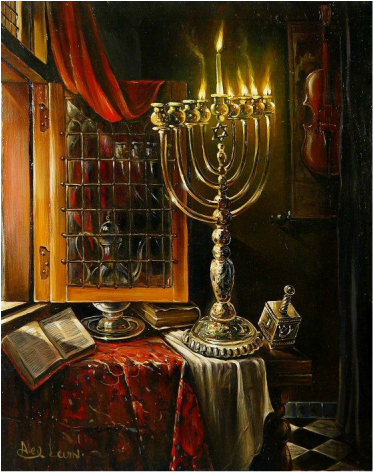
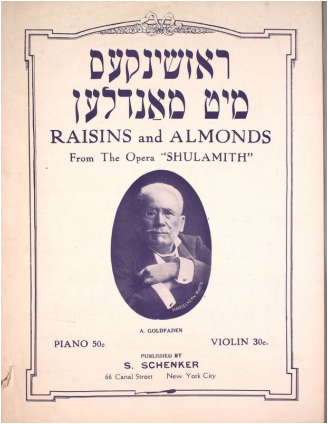



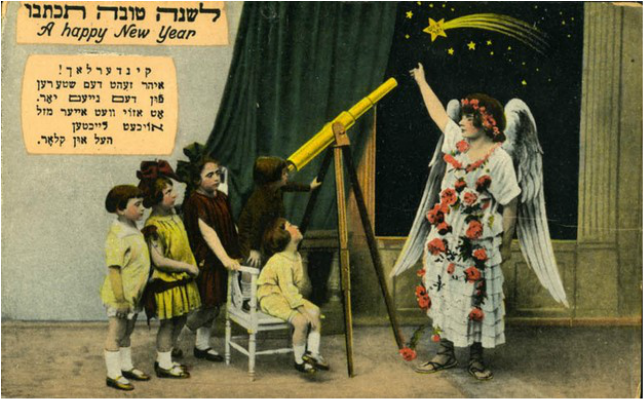

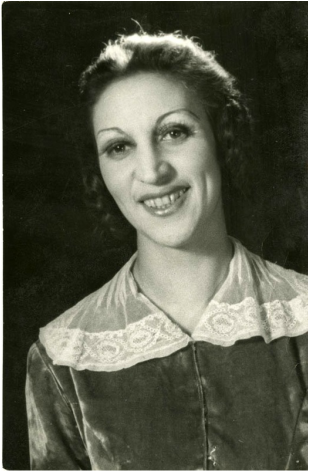







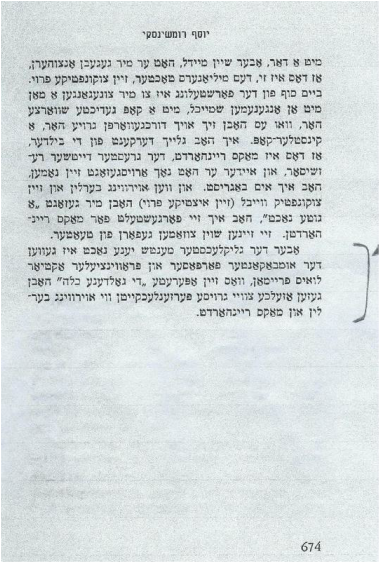
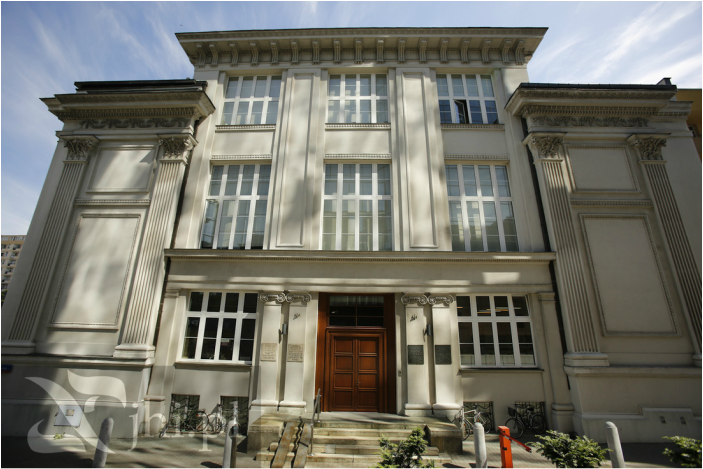




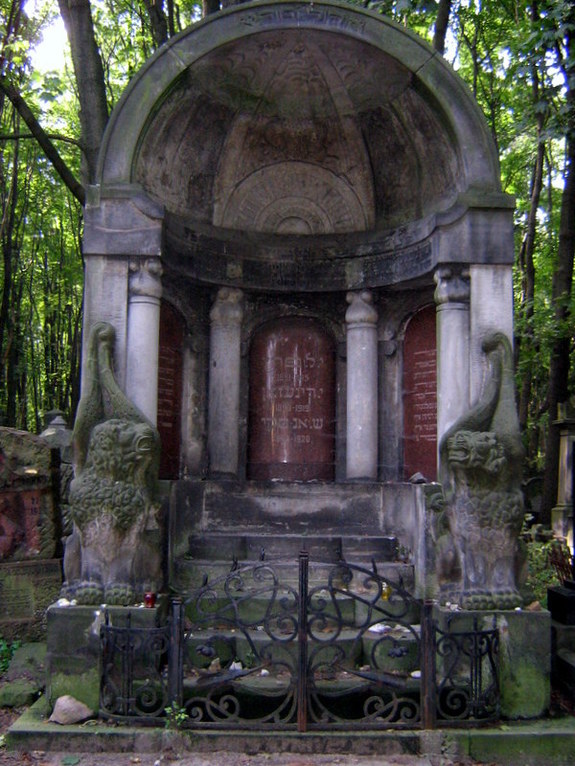

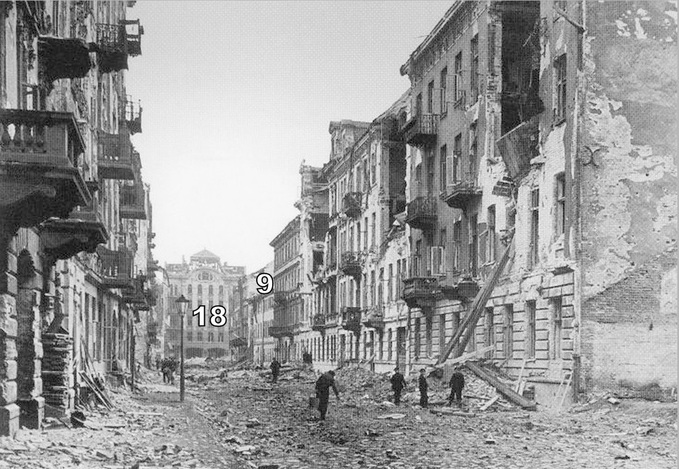
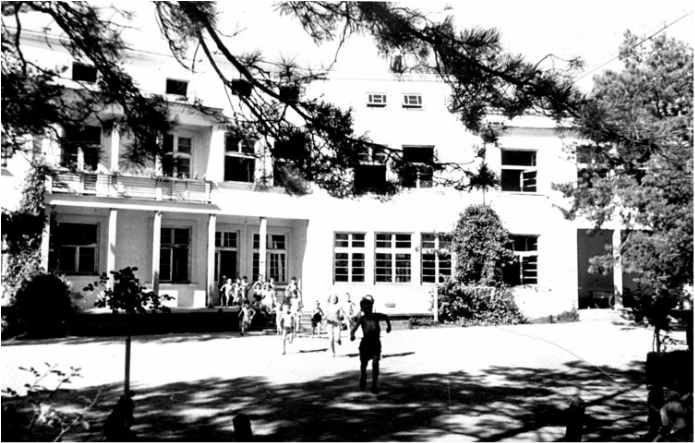




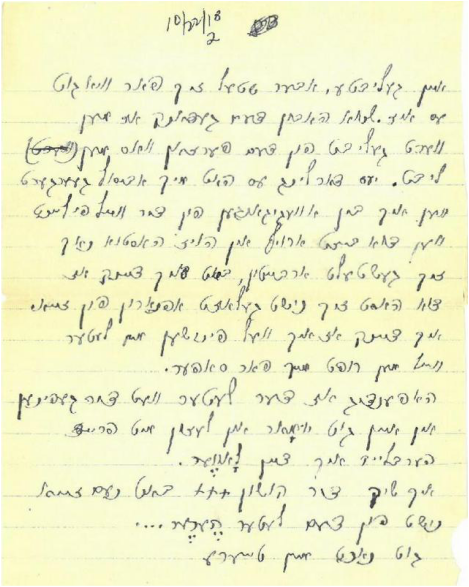

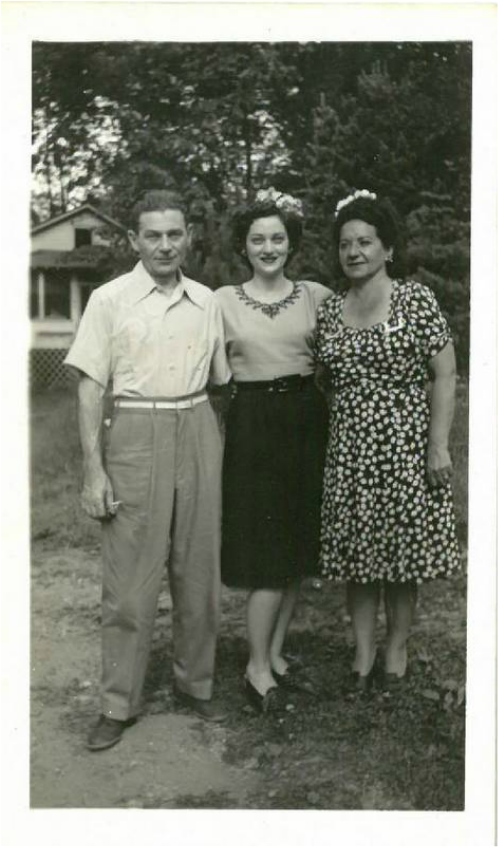
 RSS Feed
RSS Feed